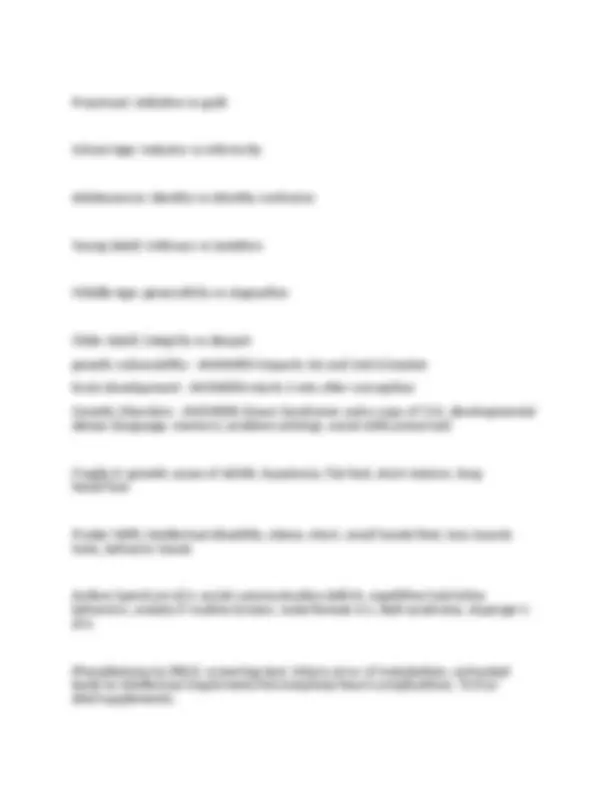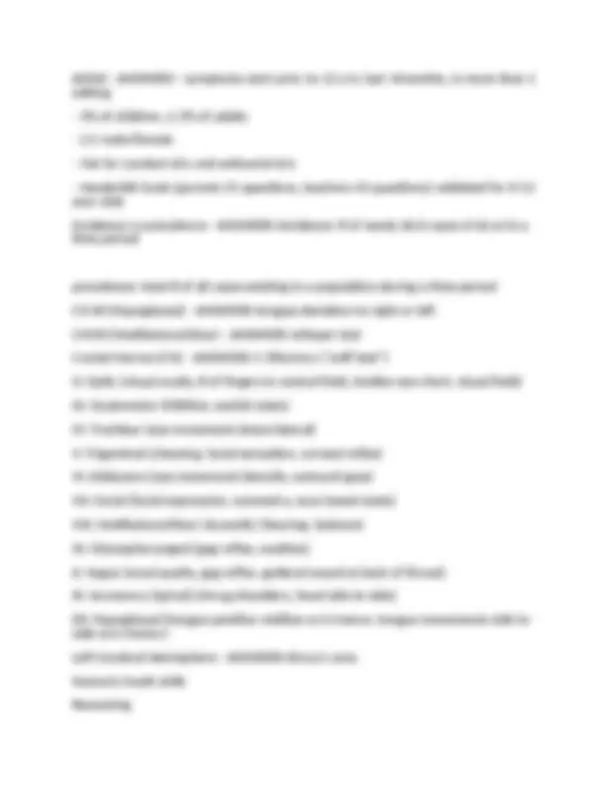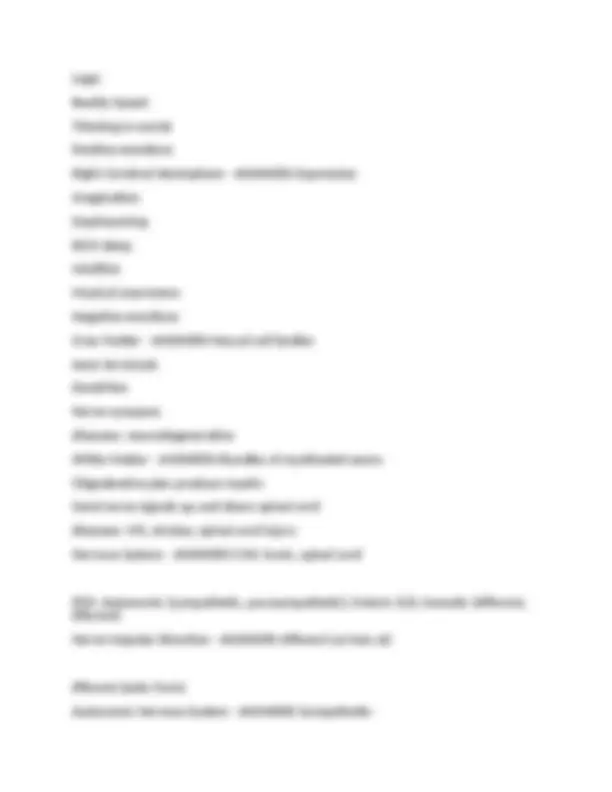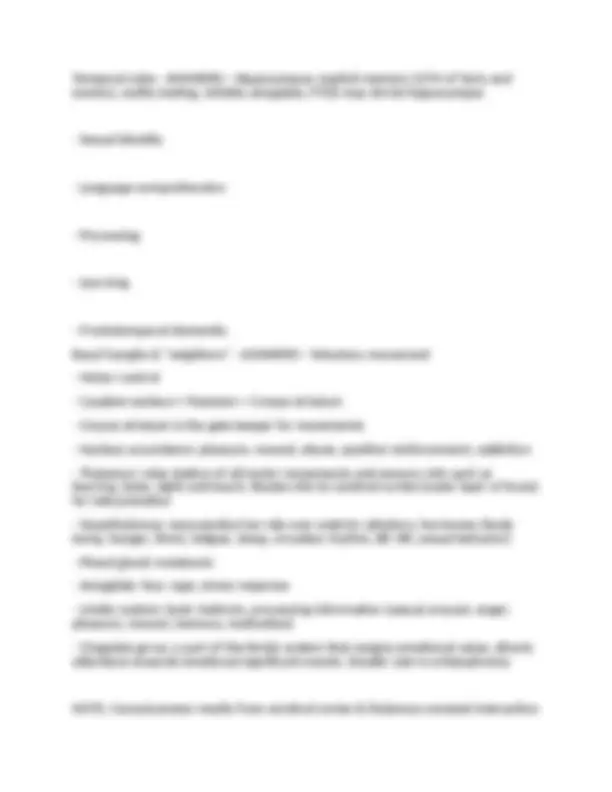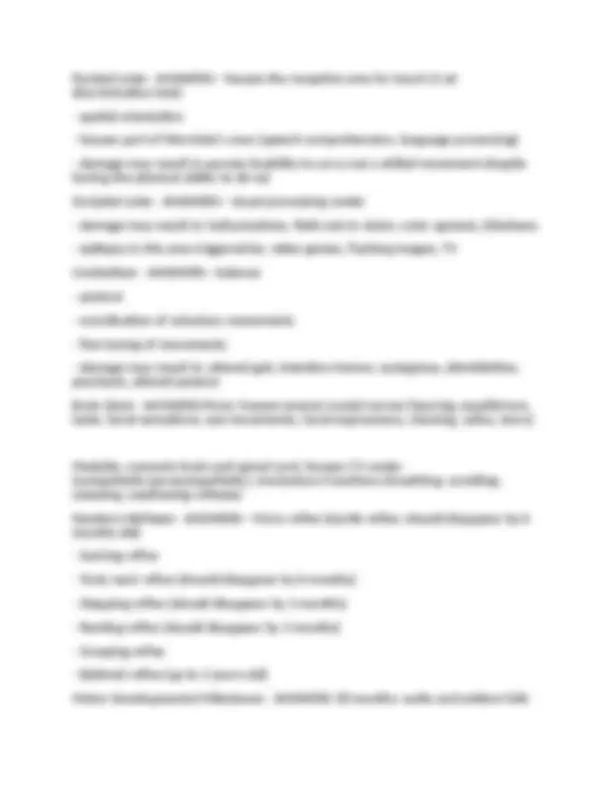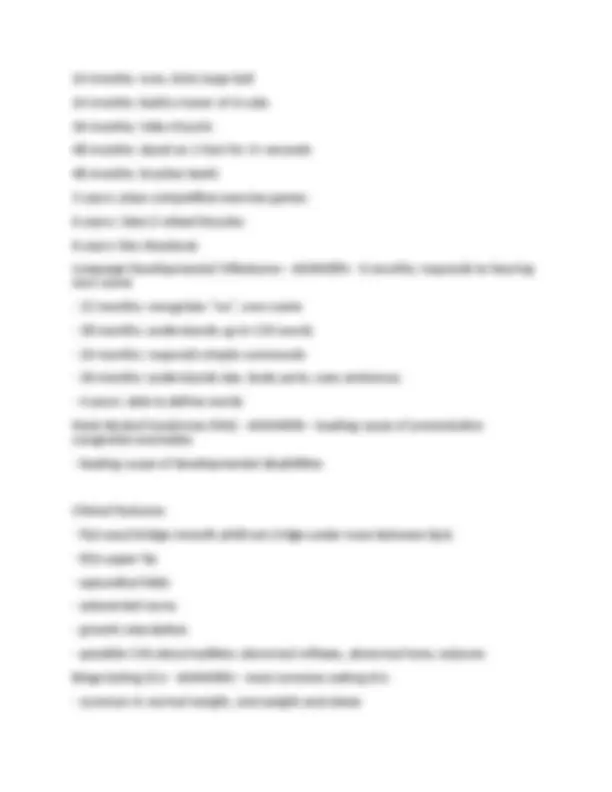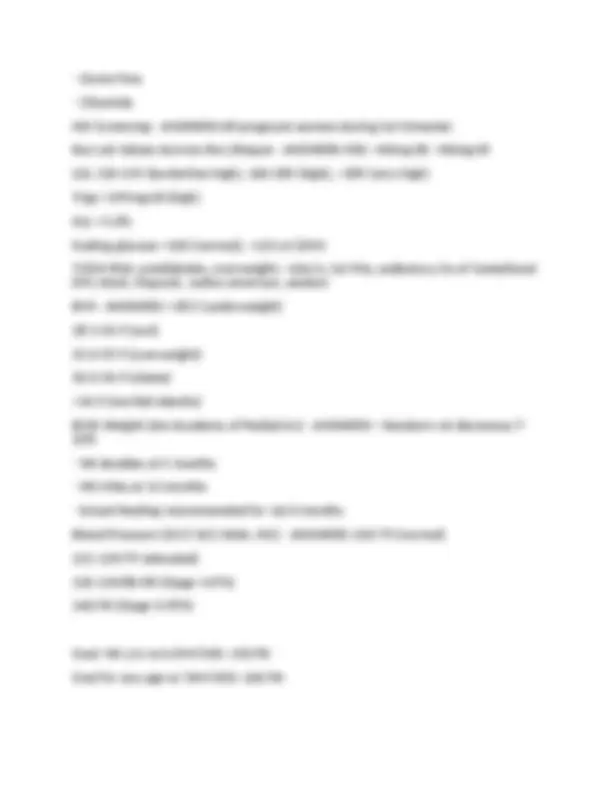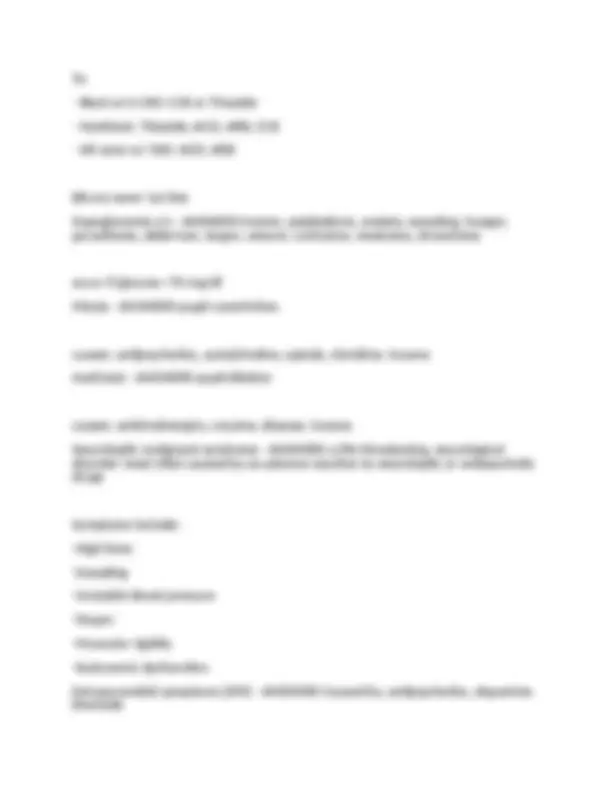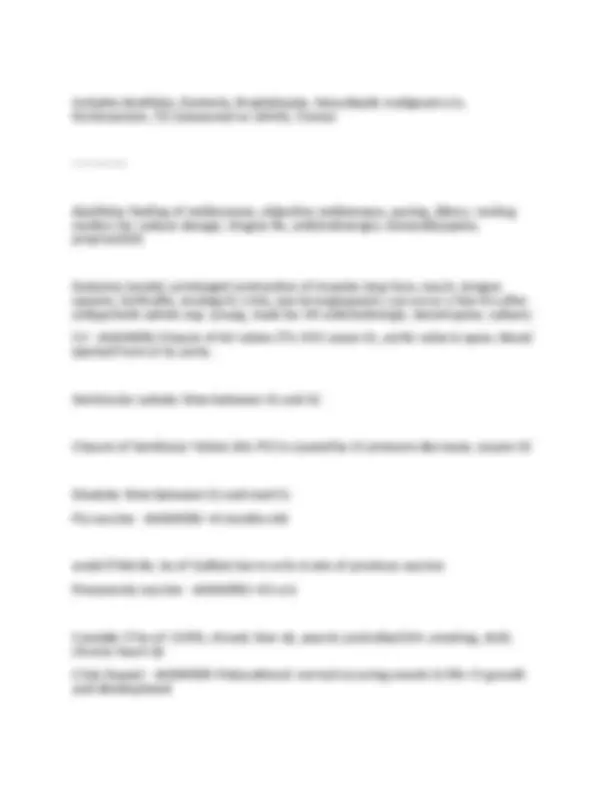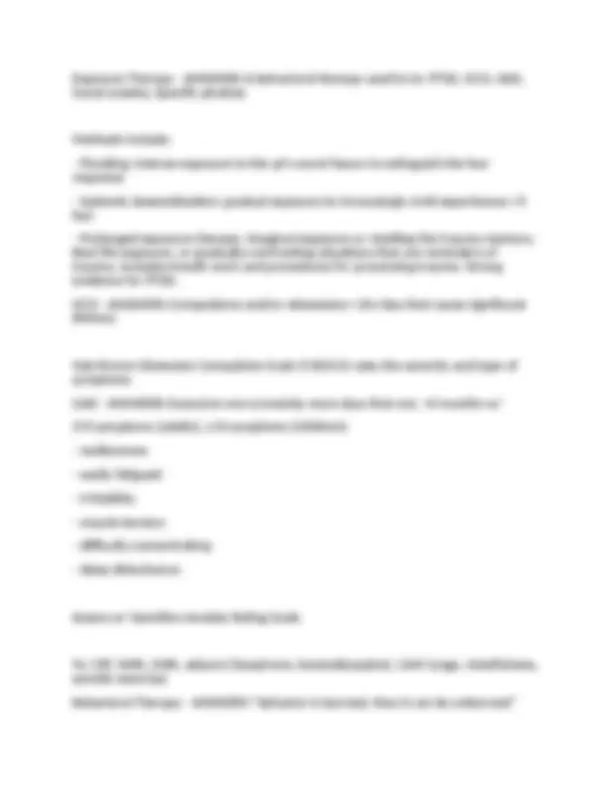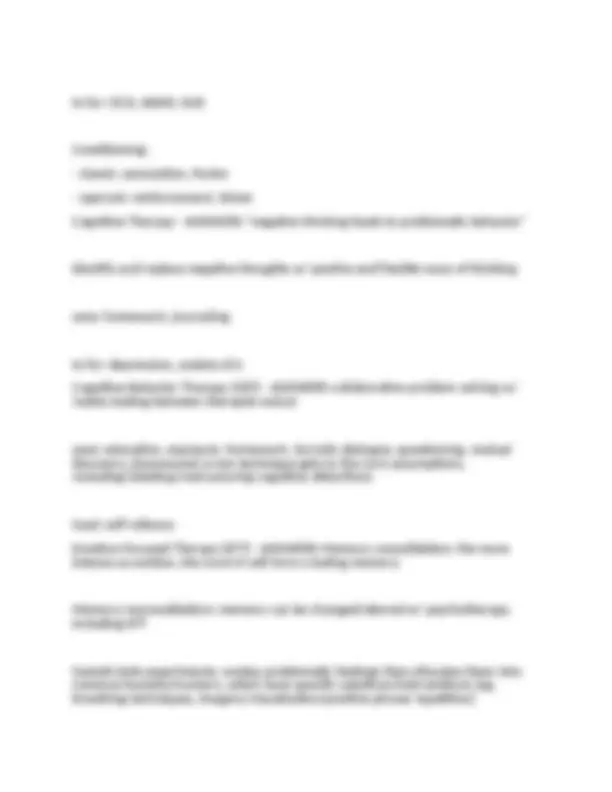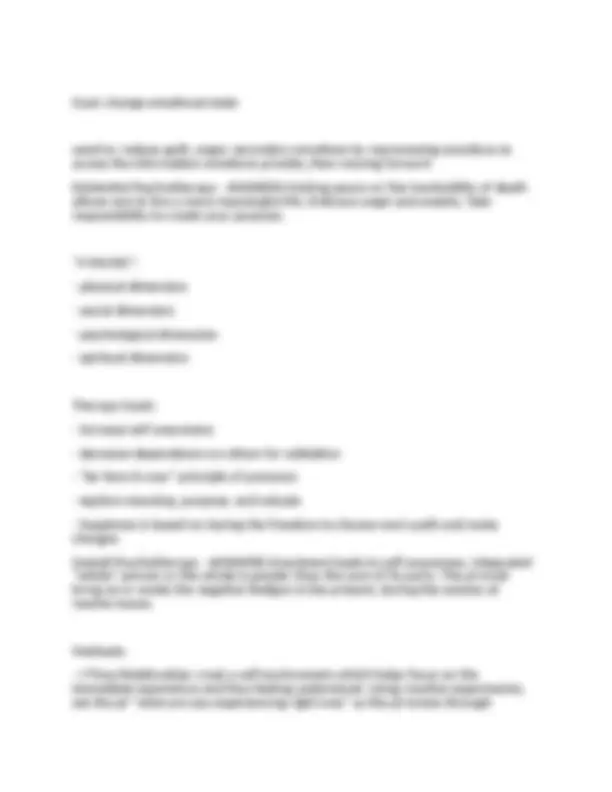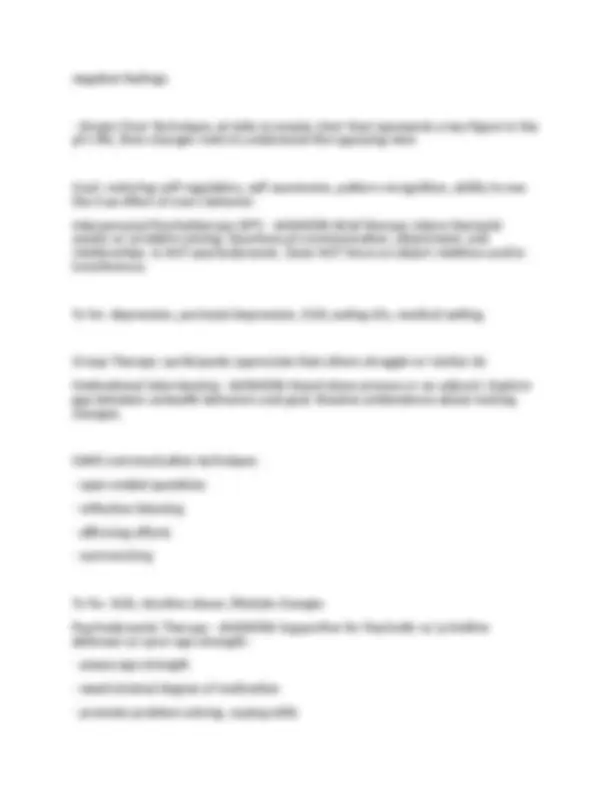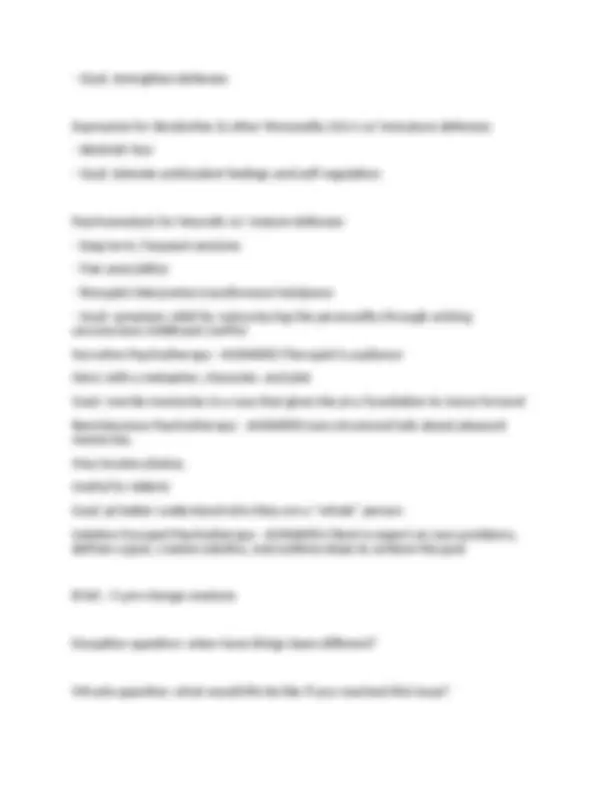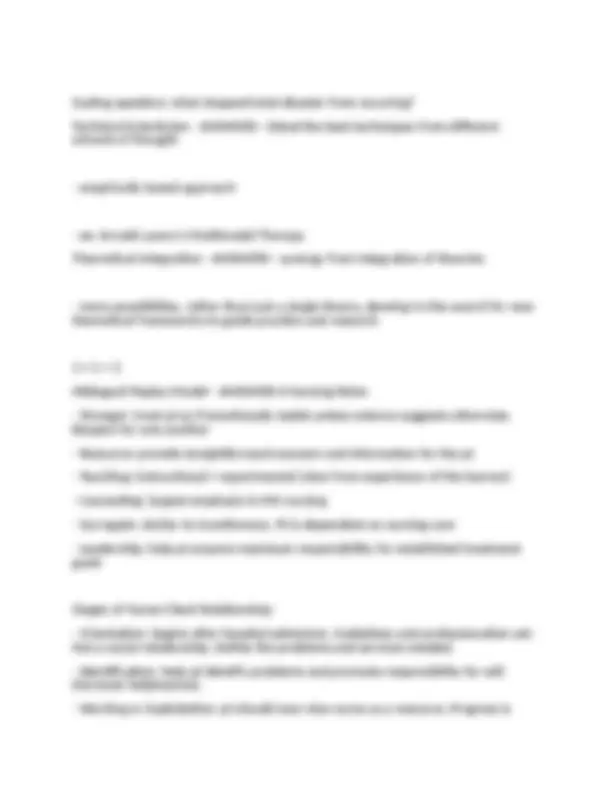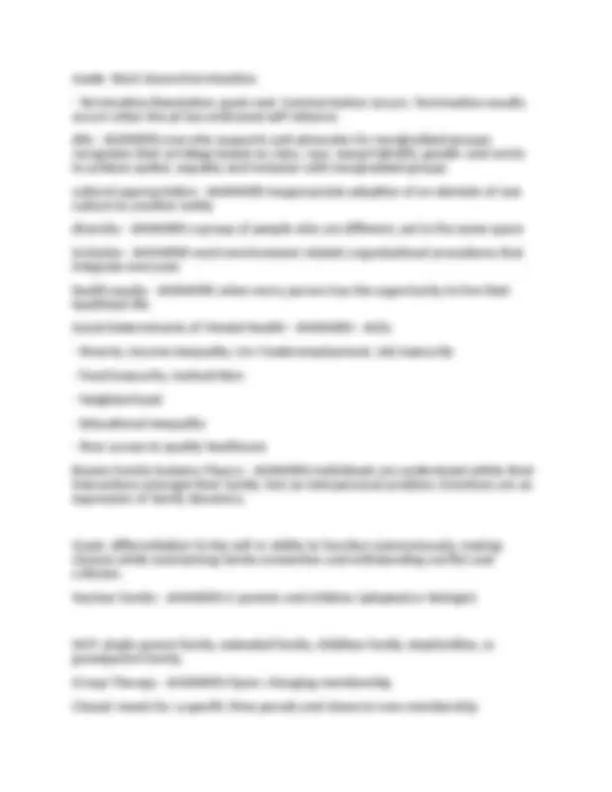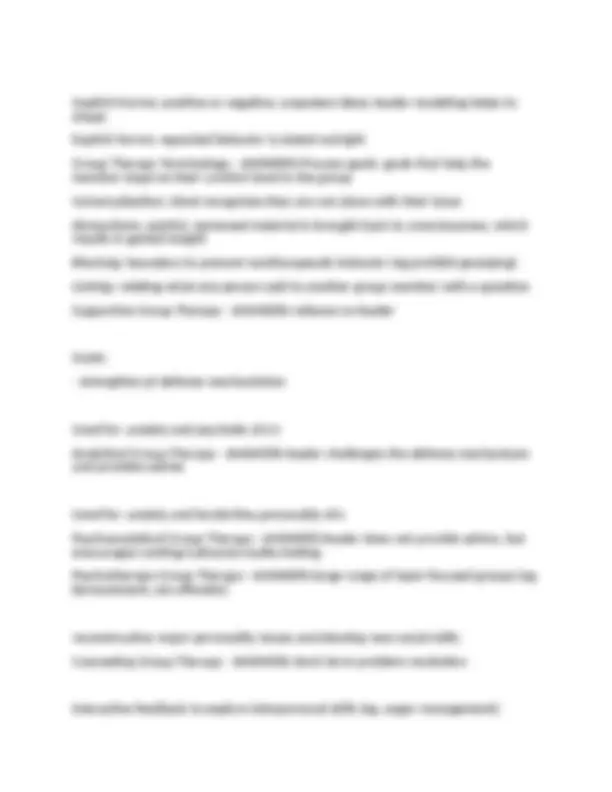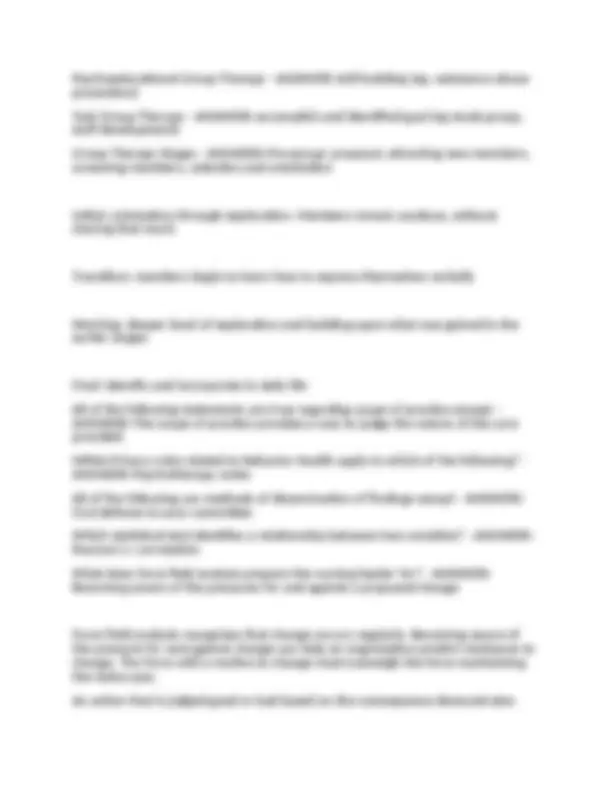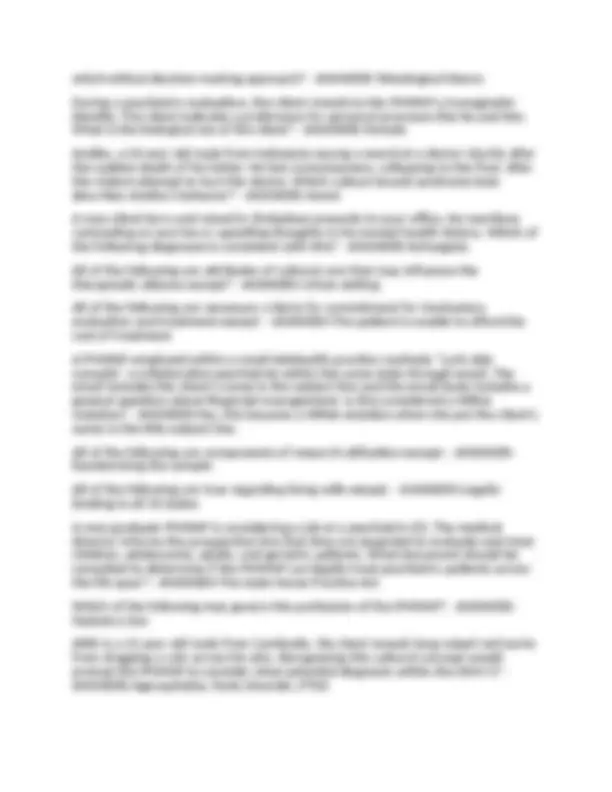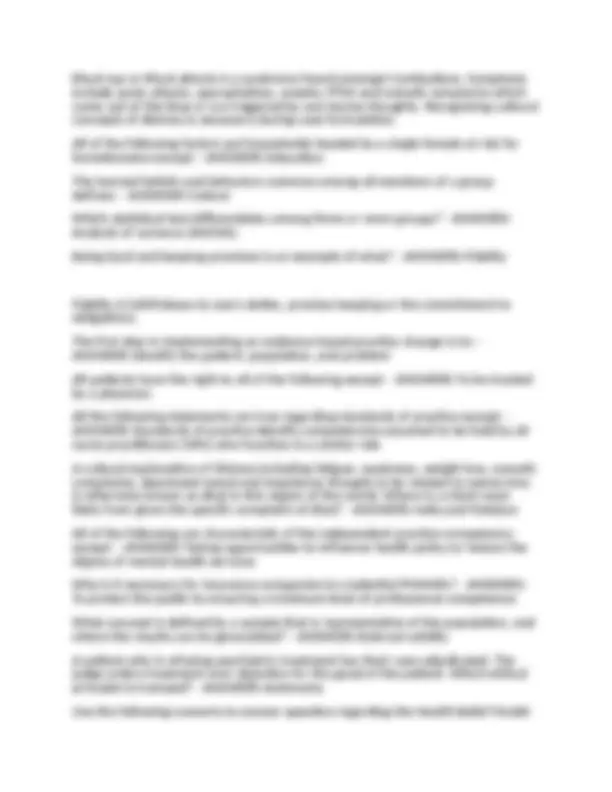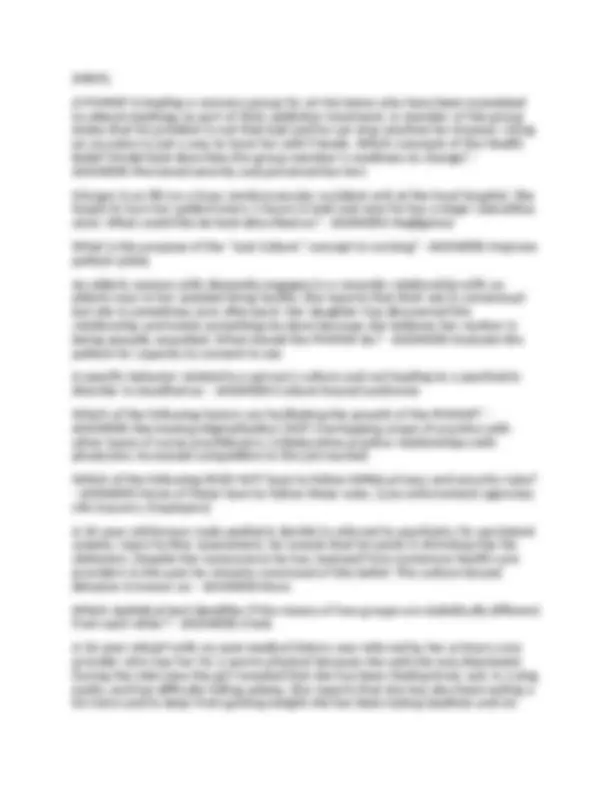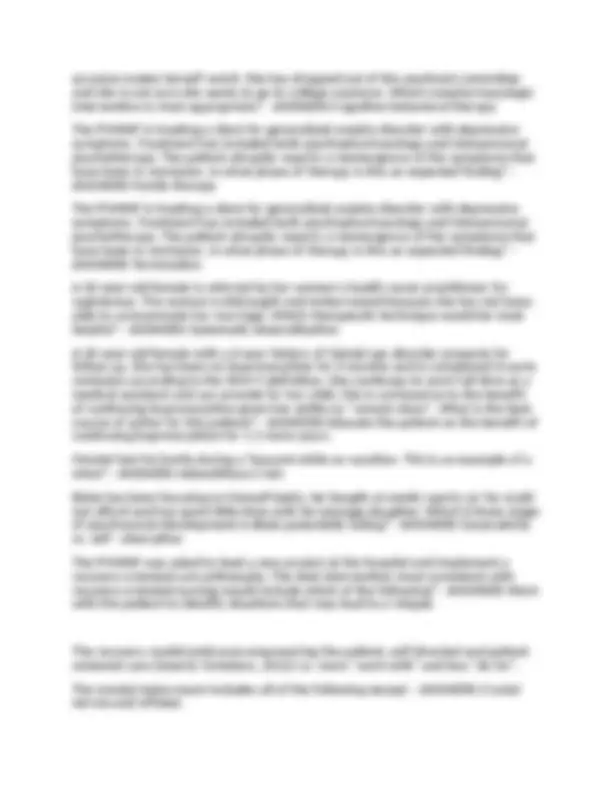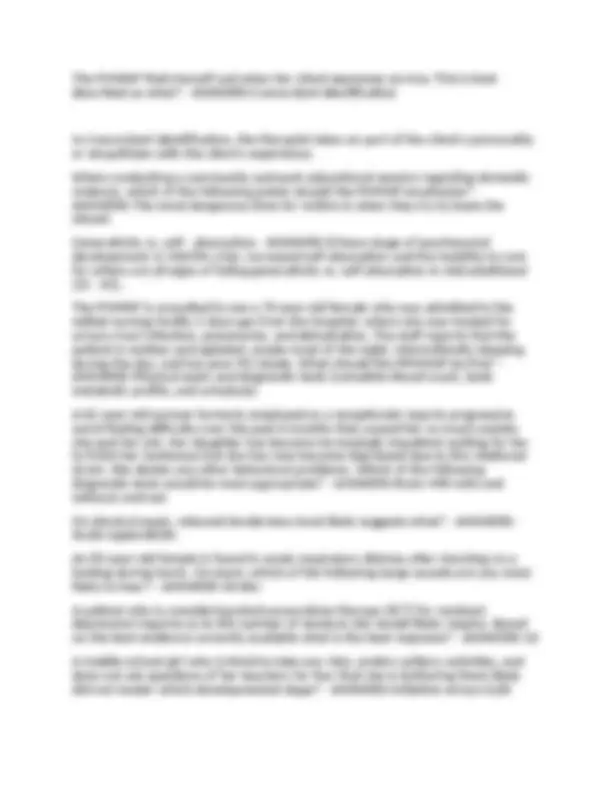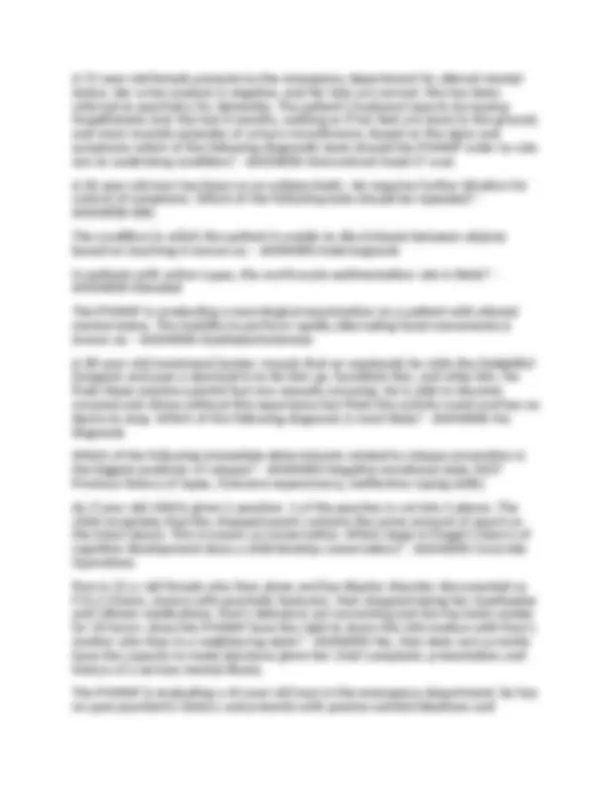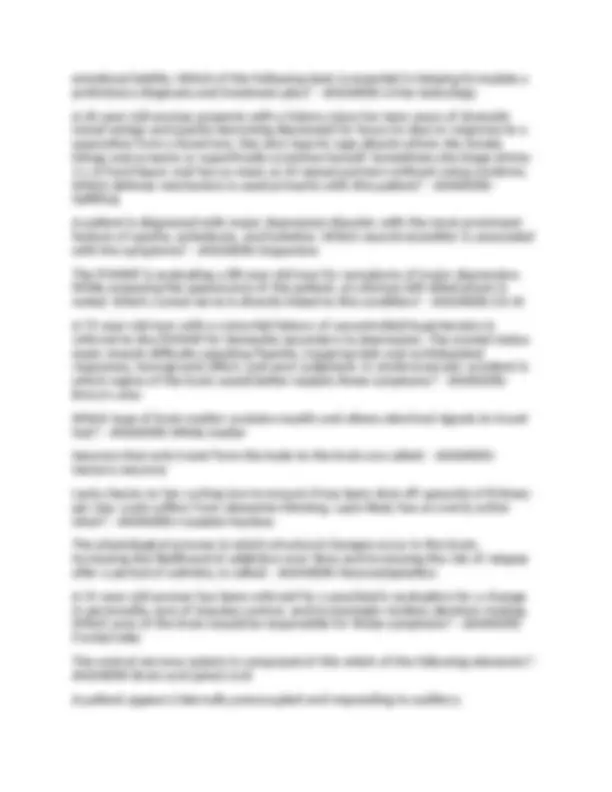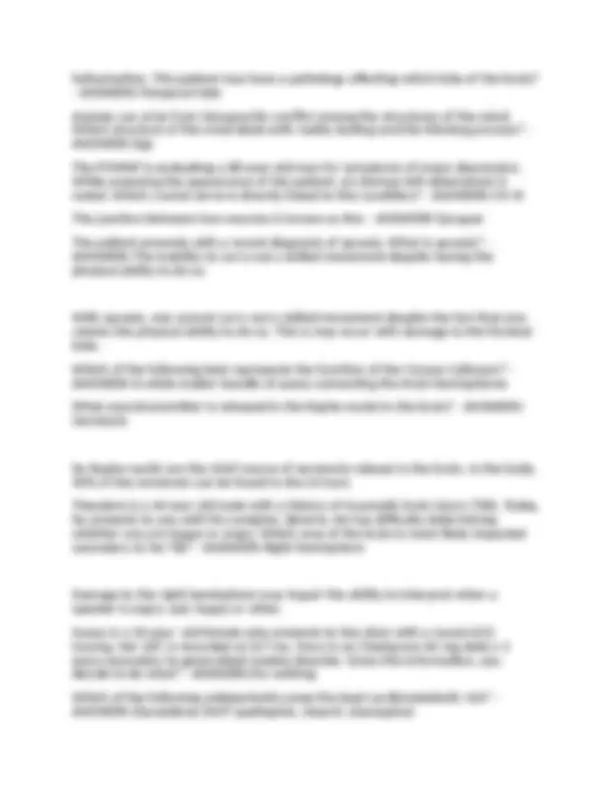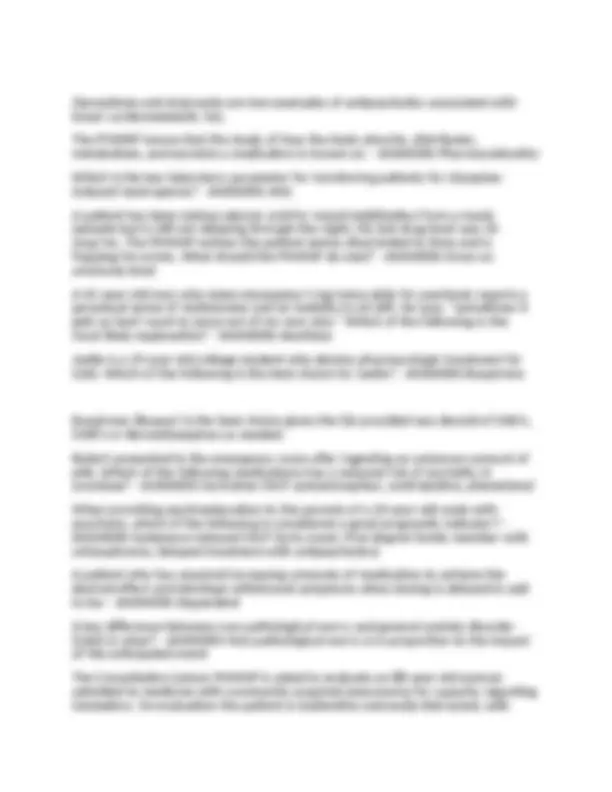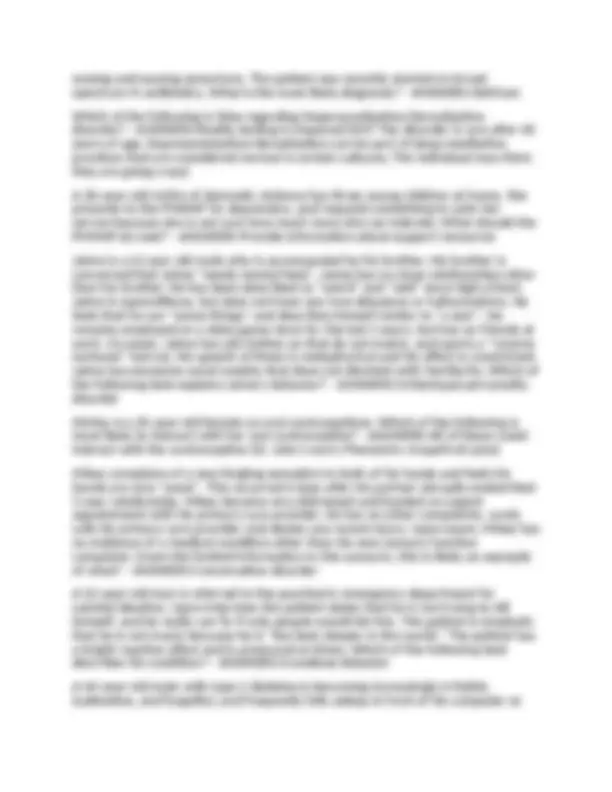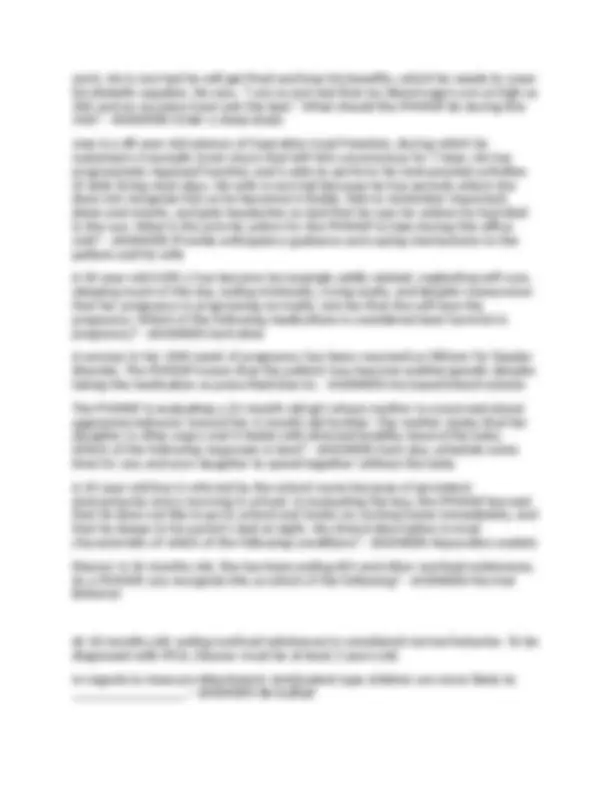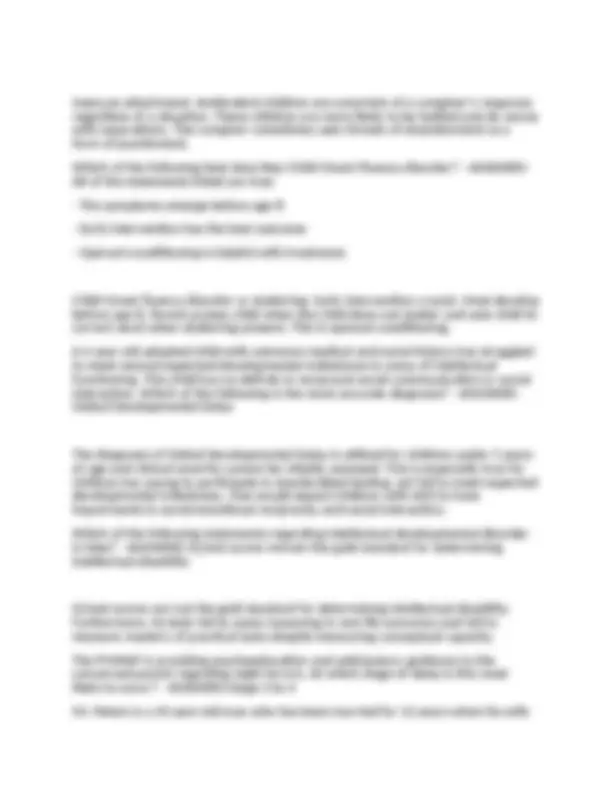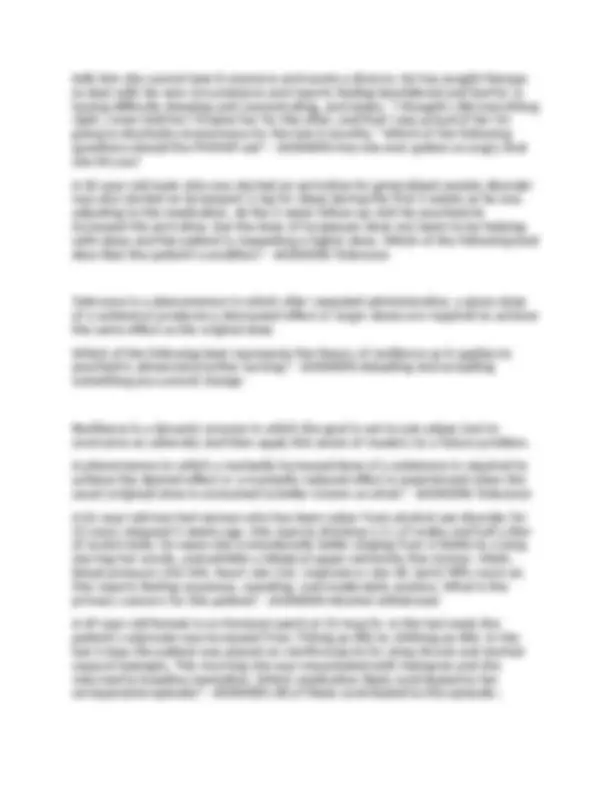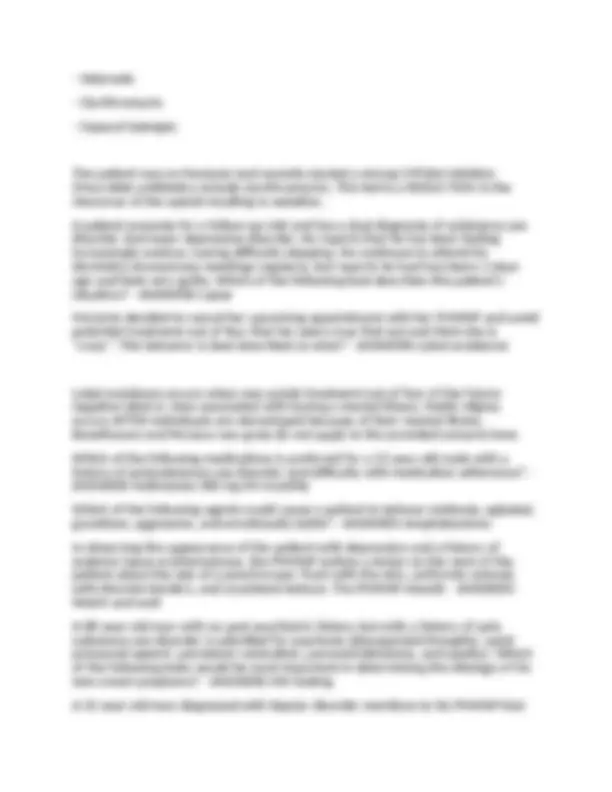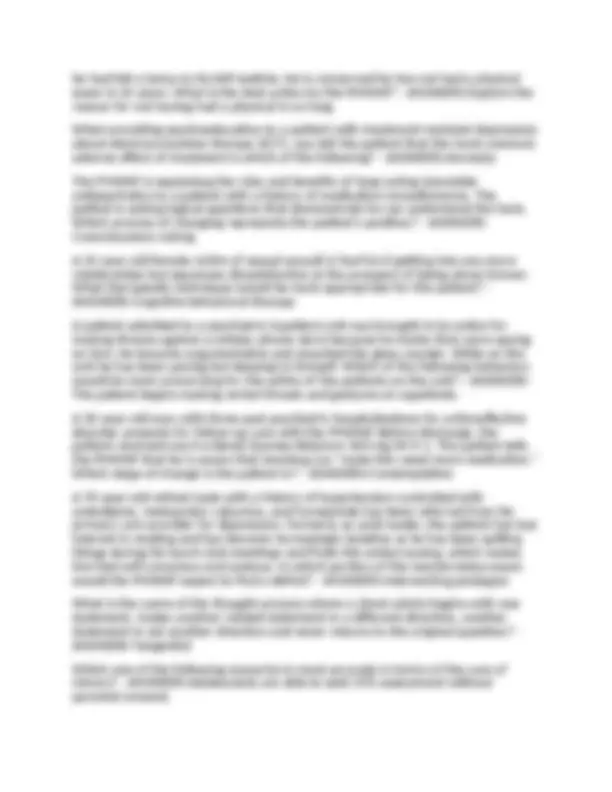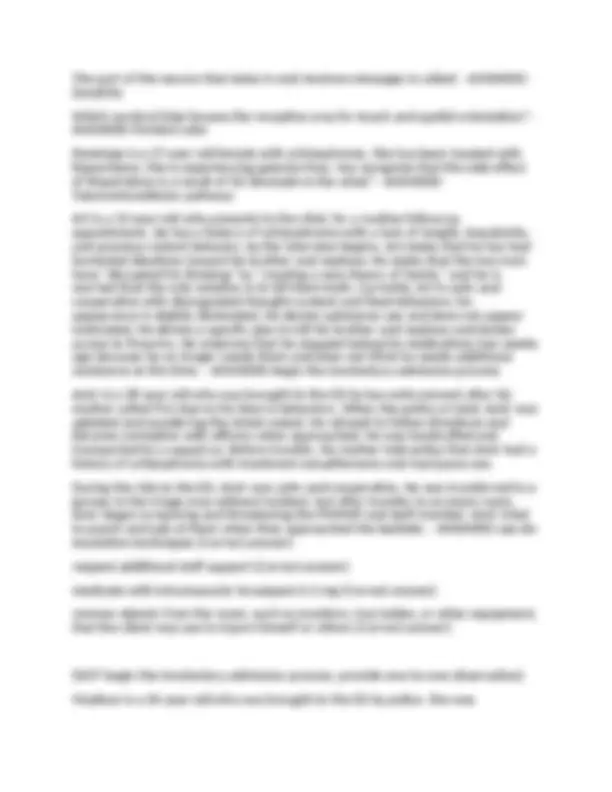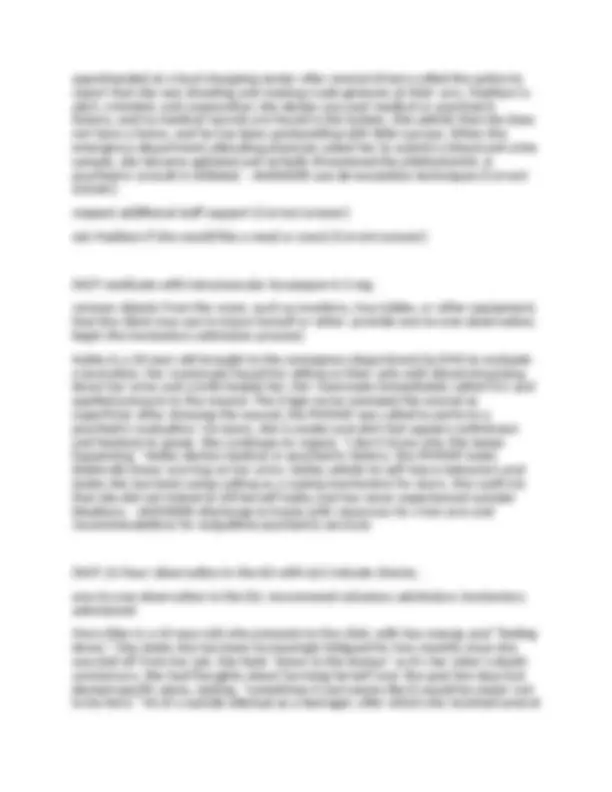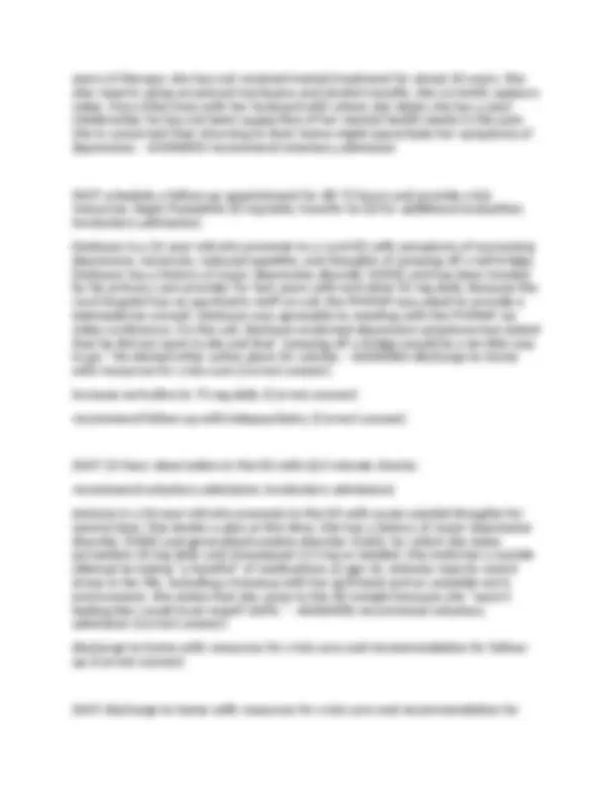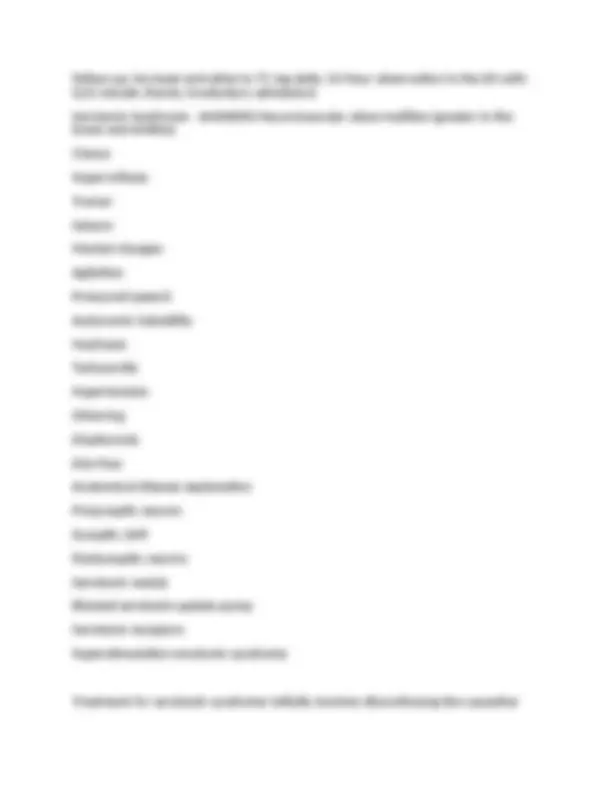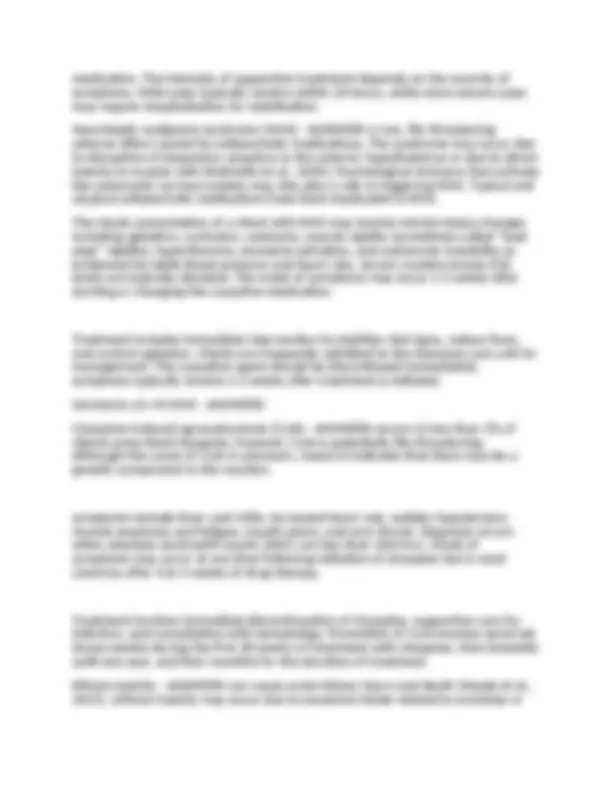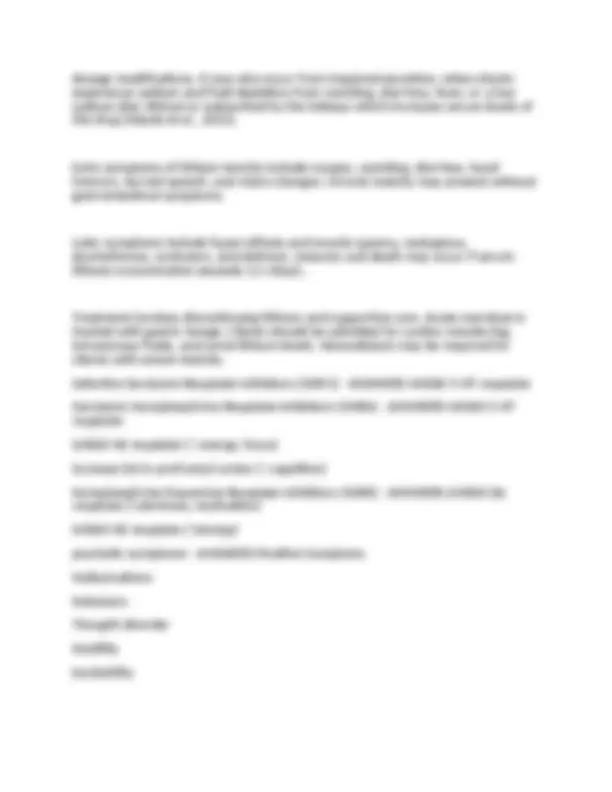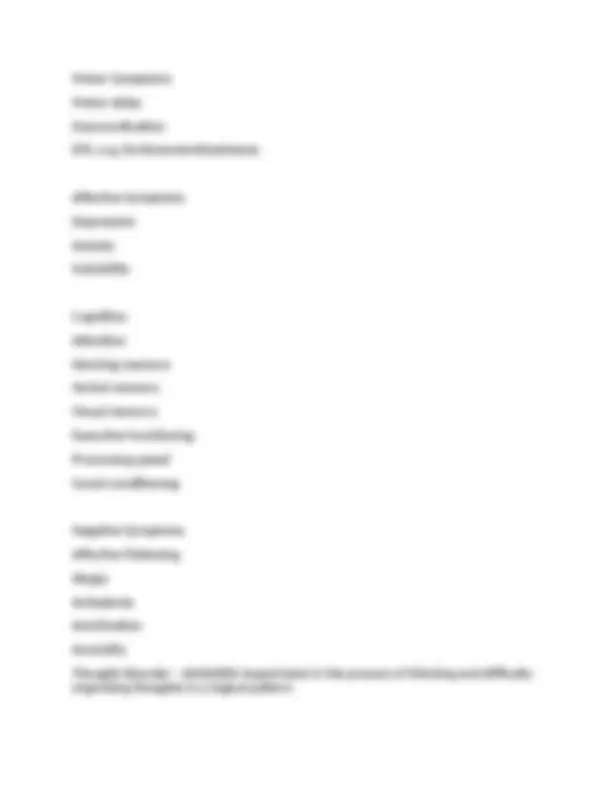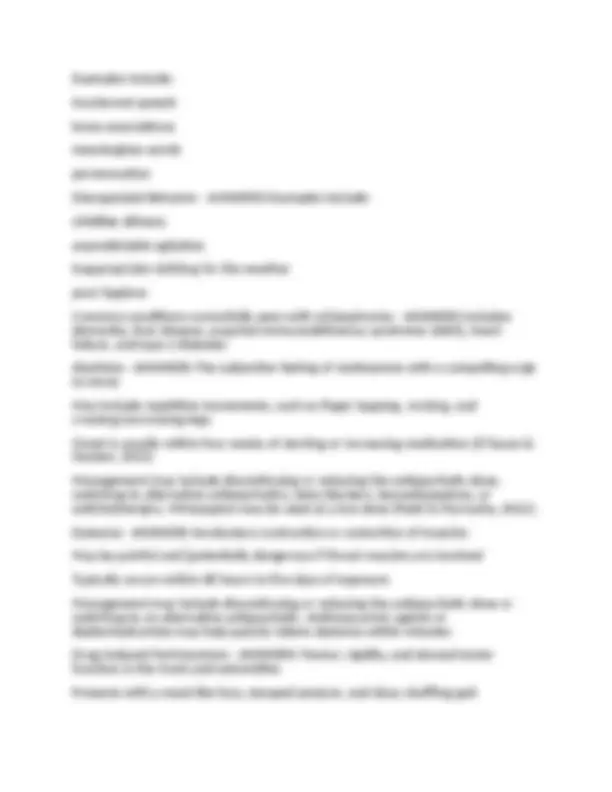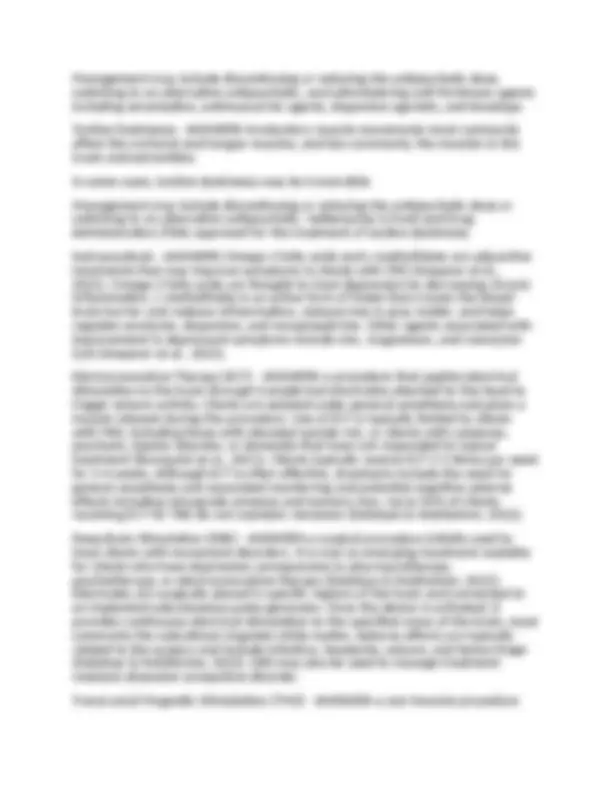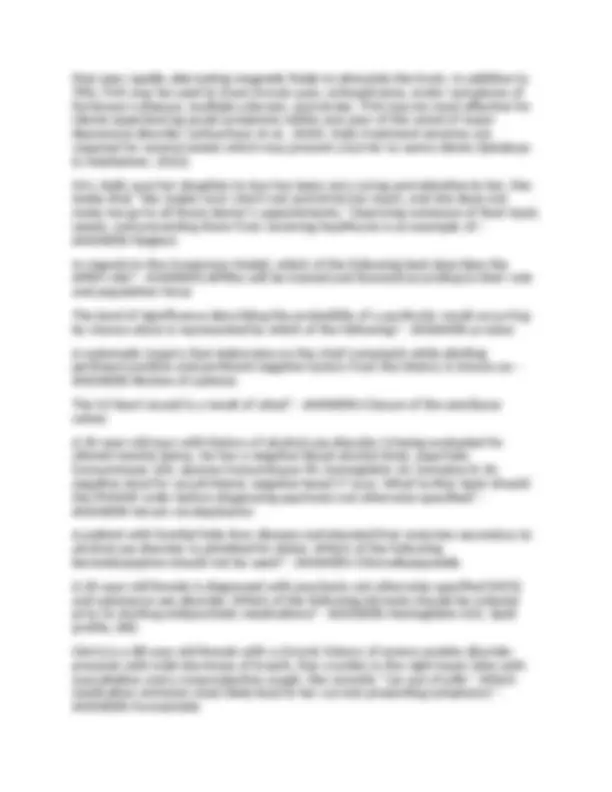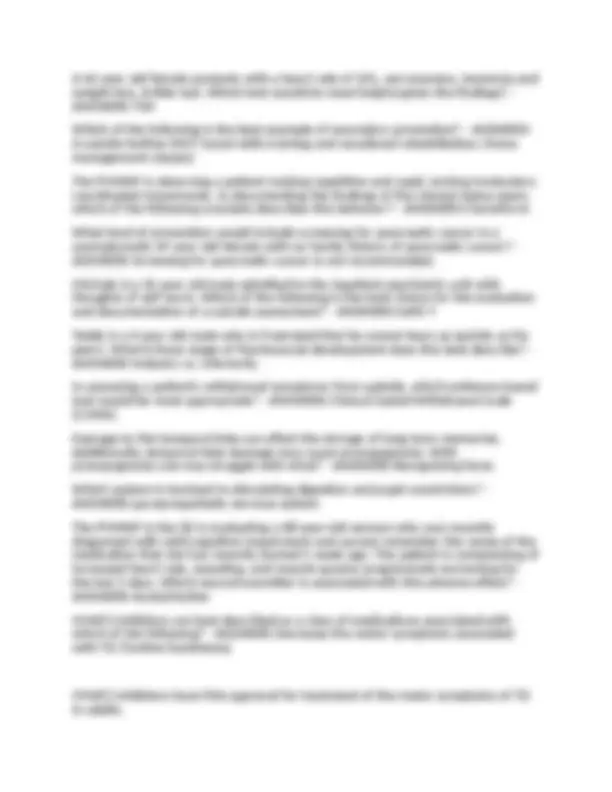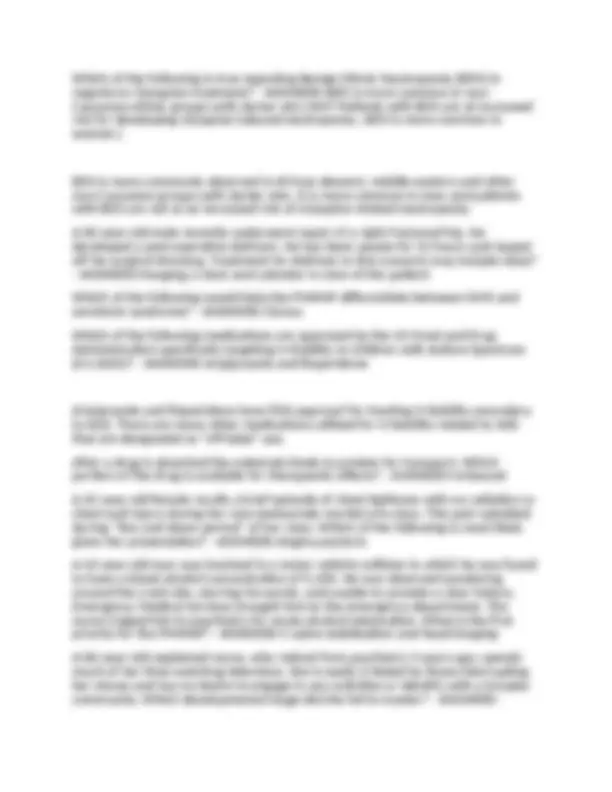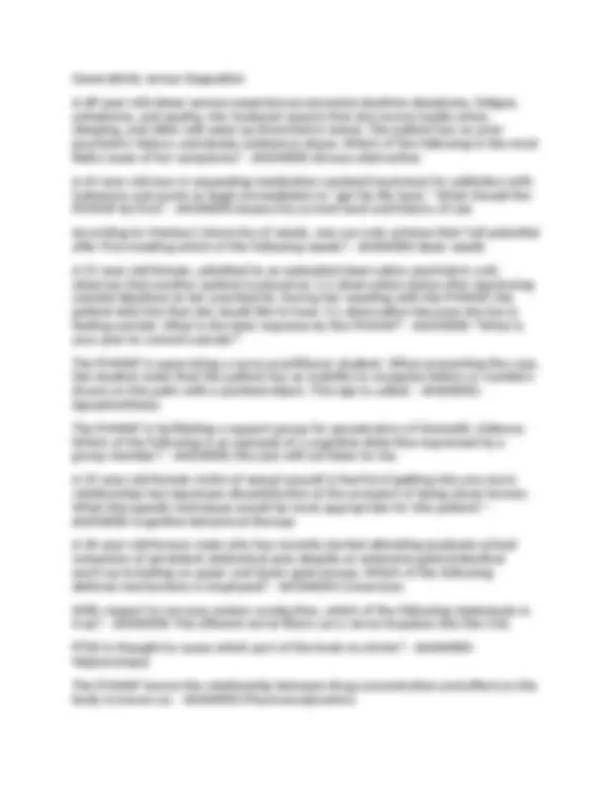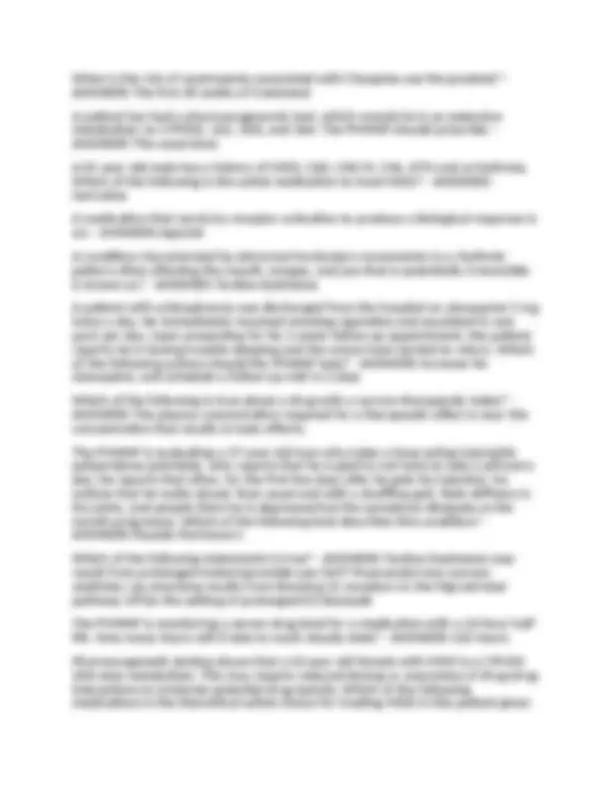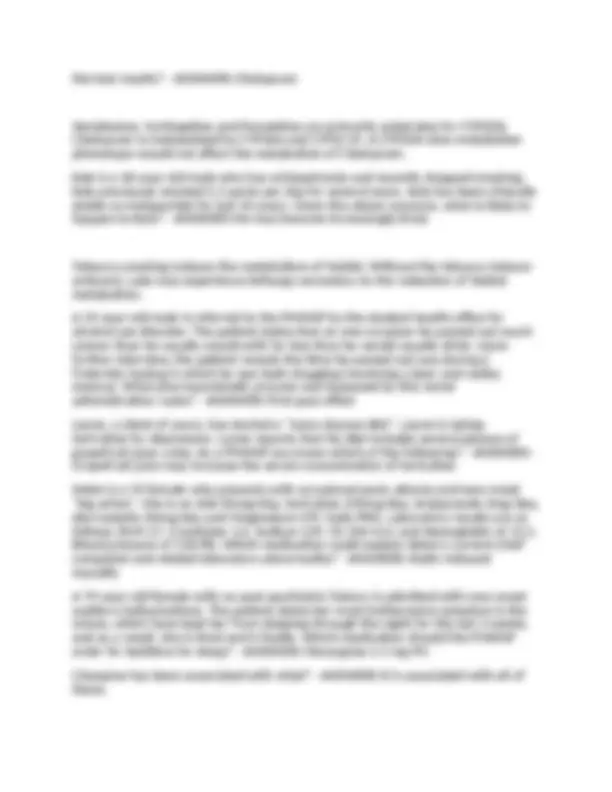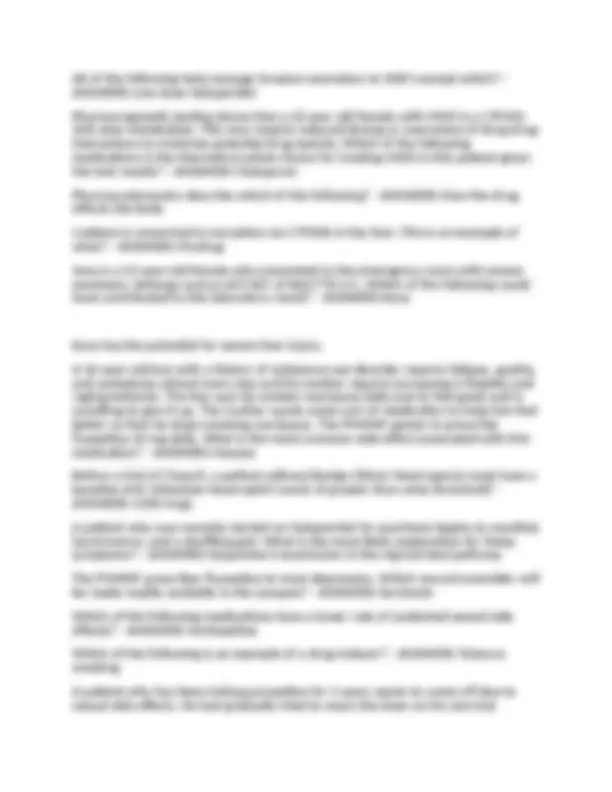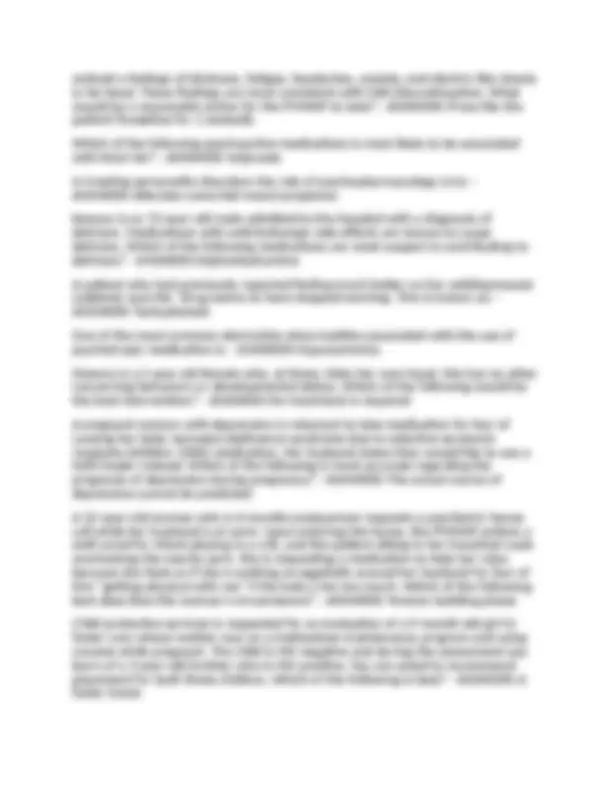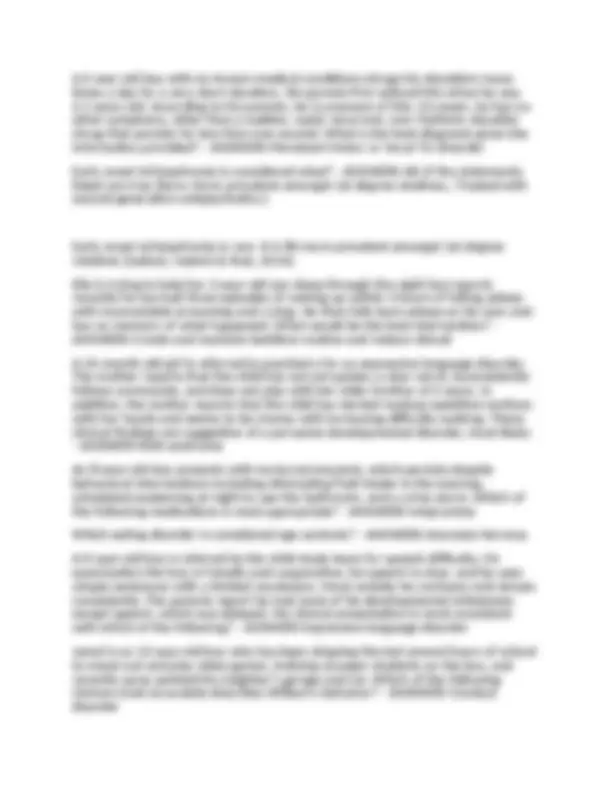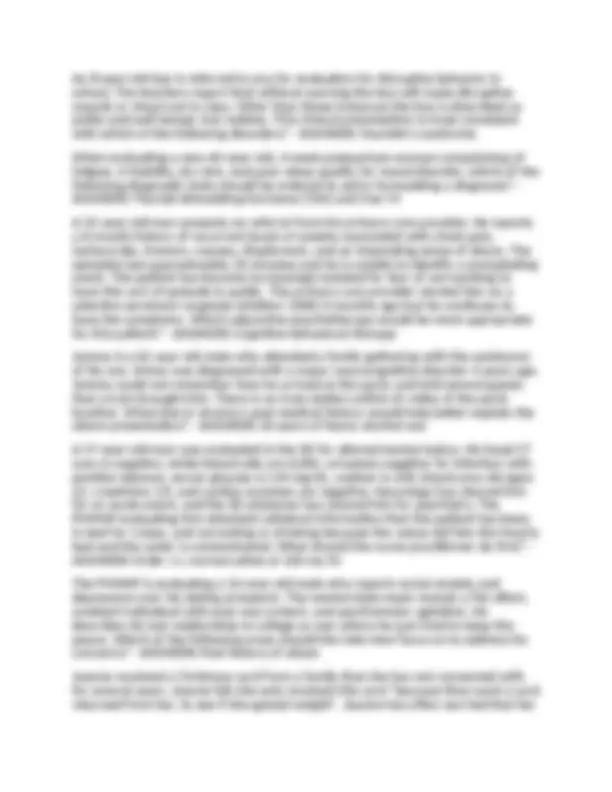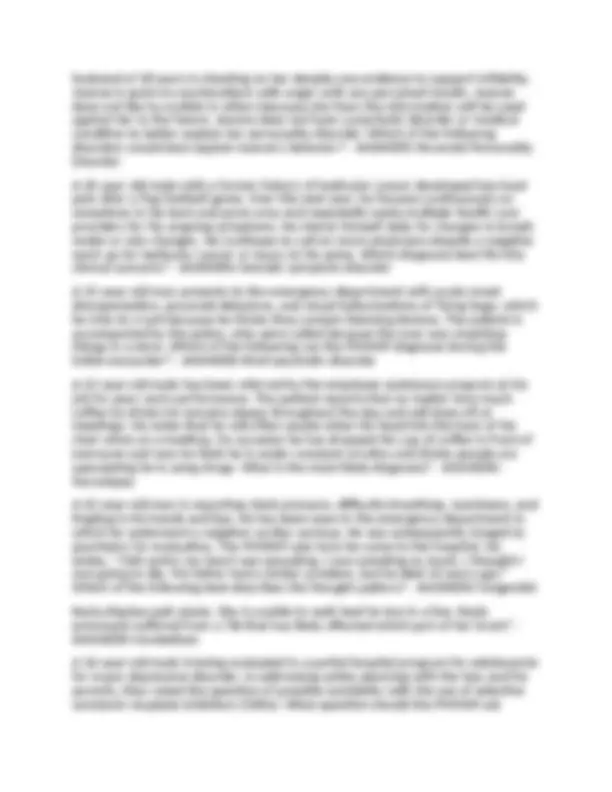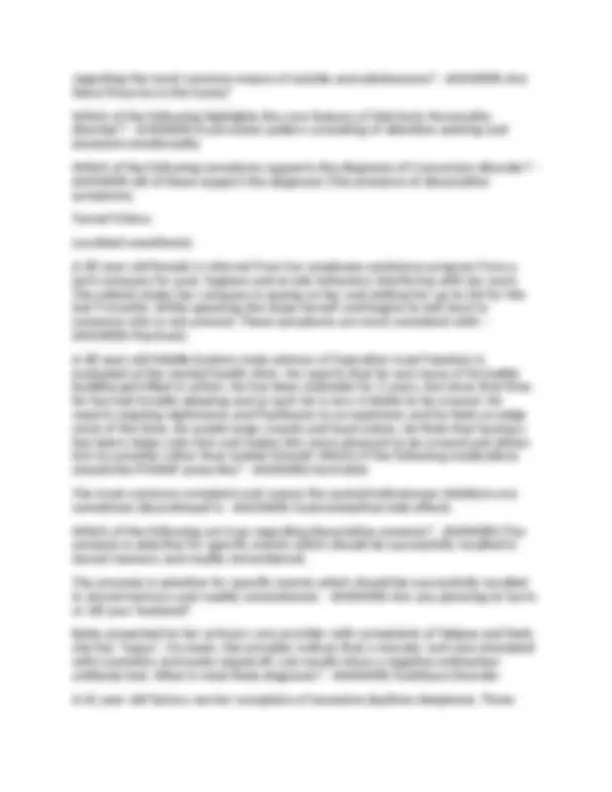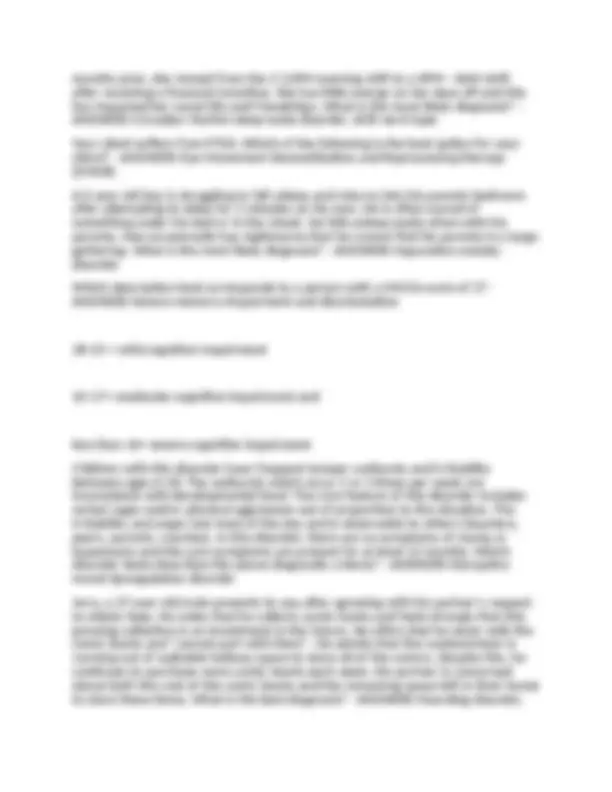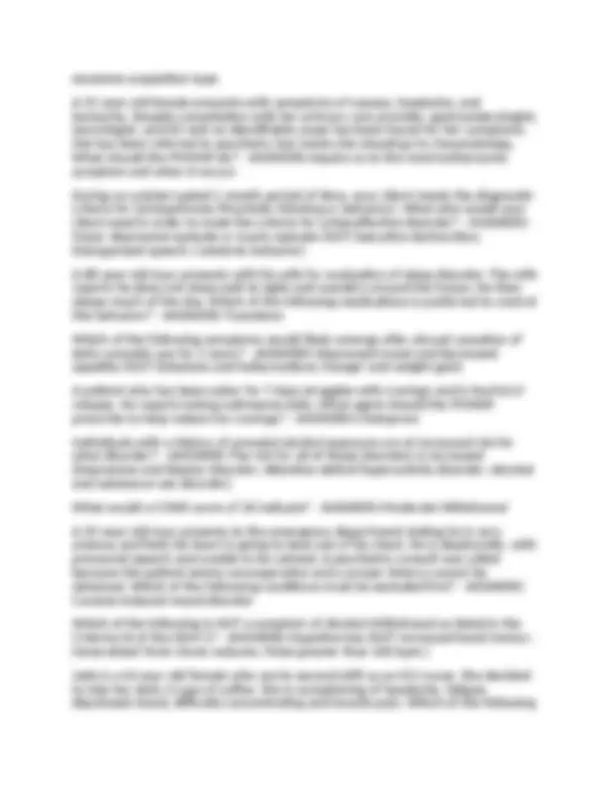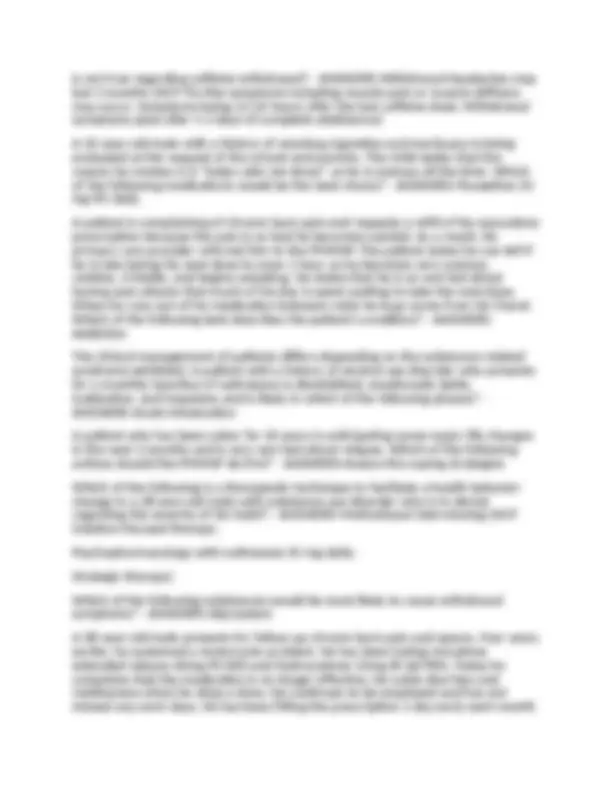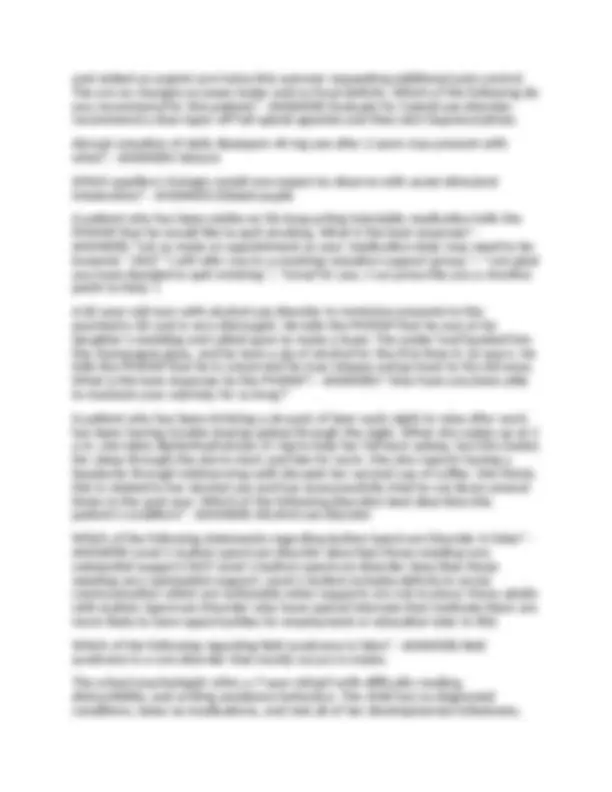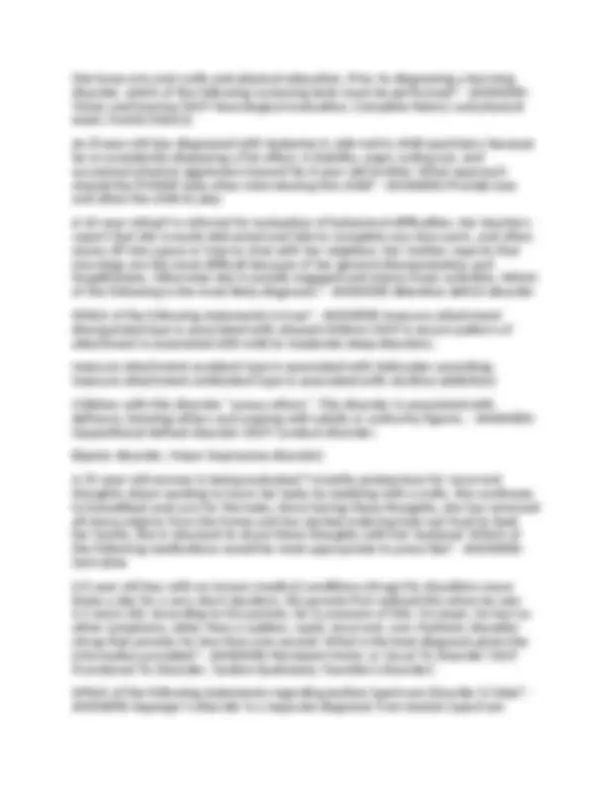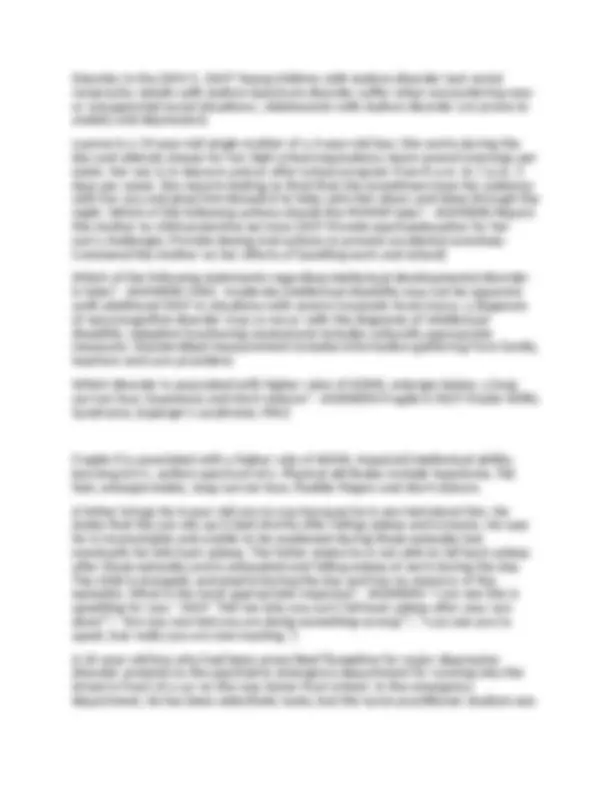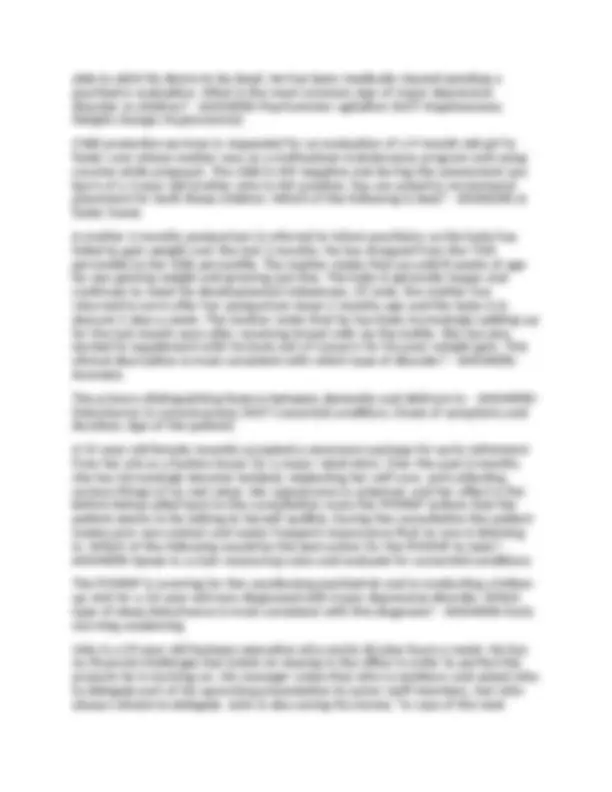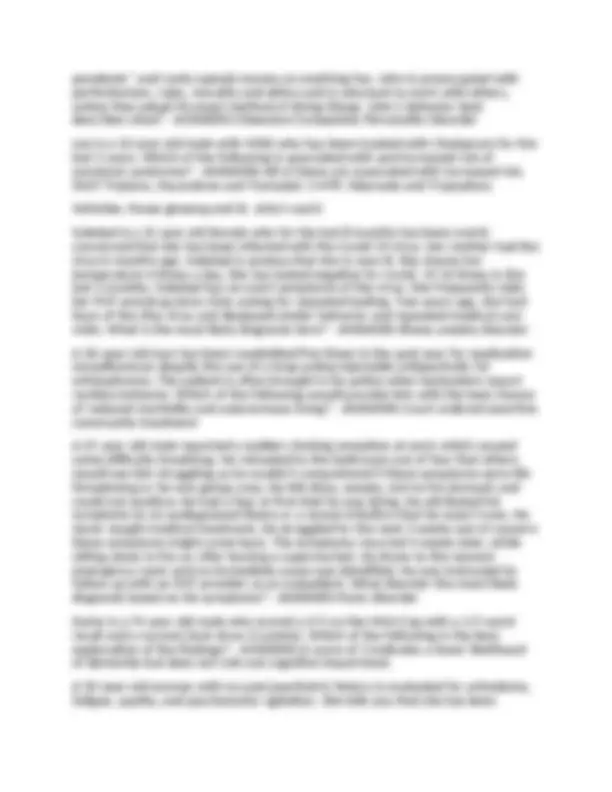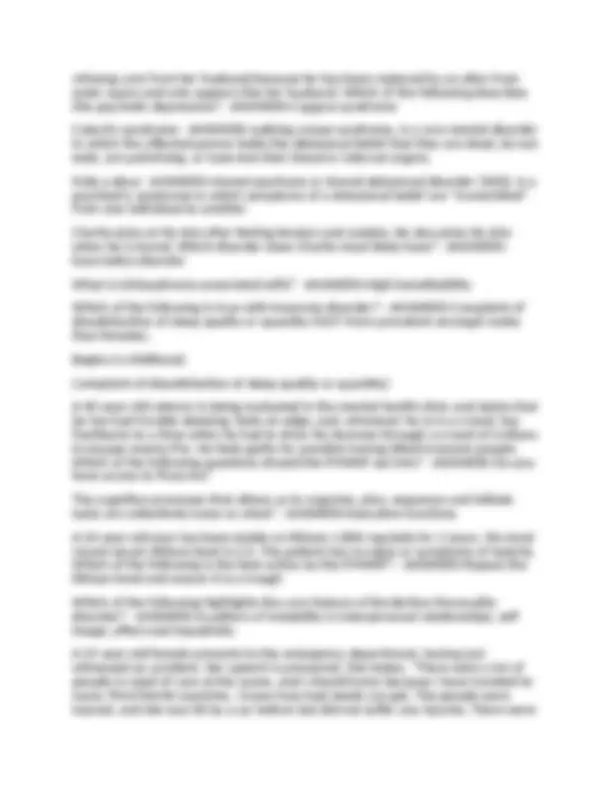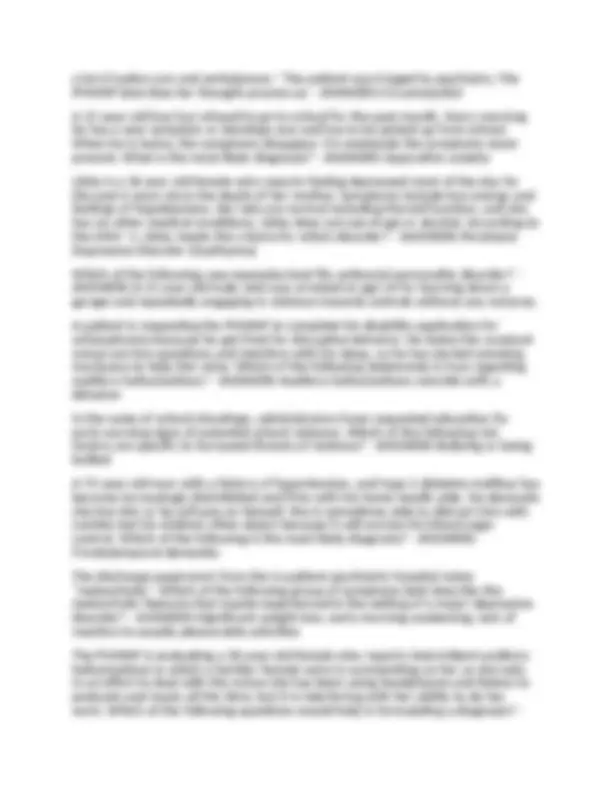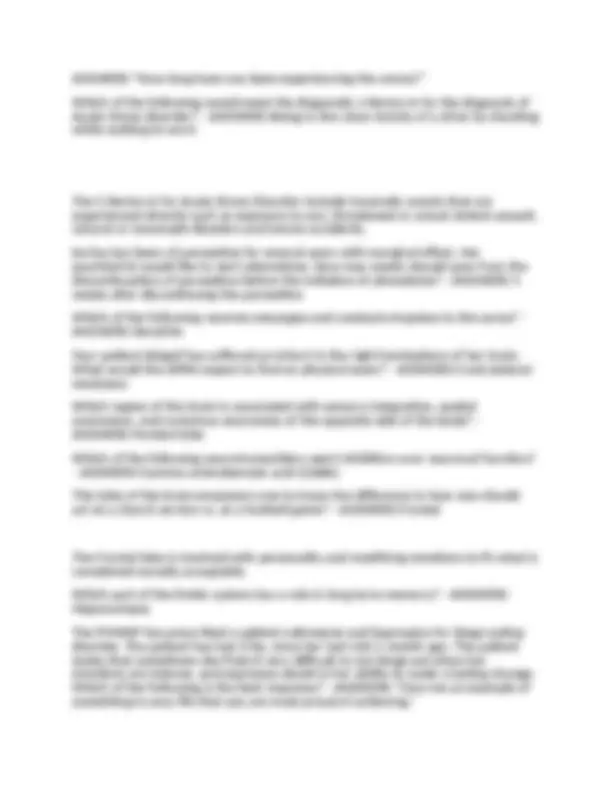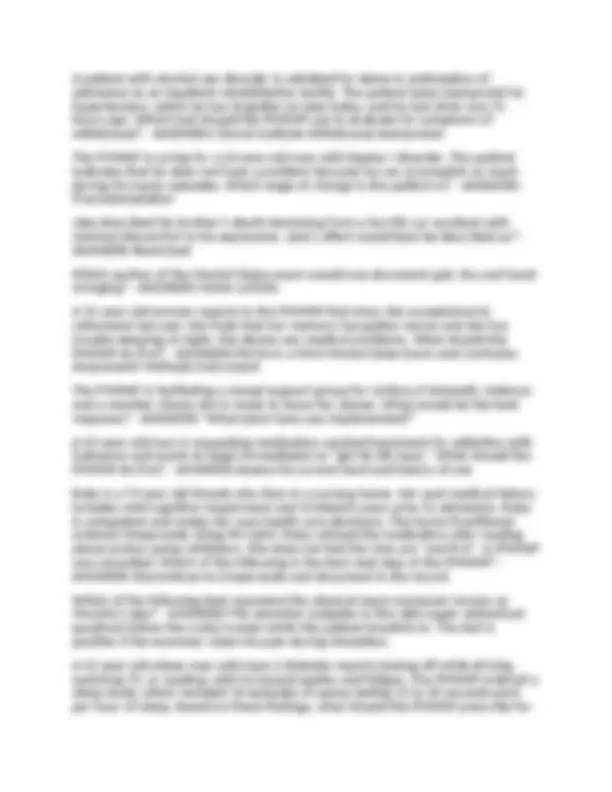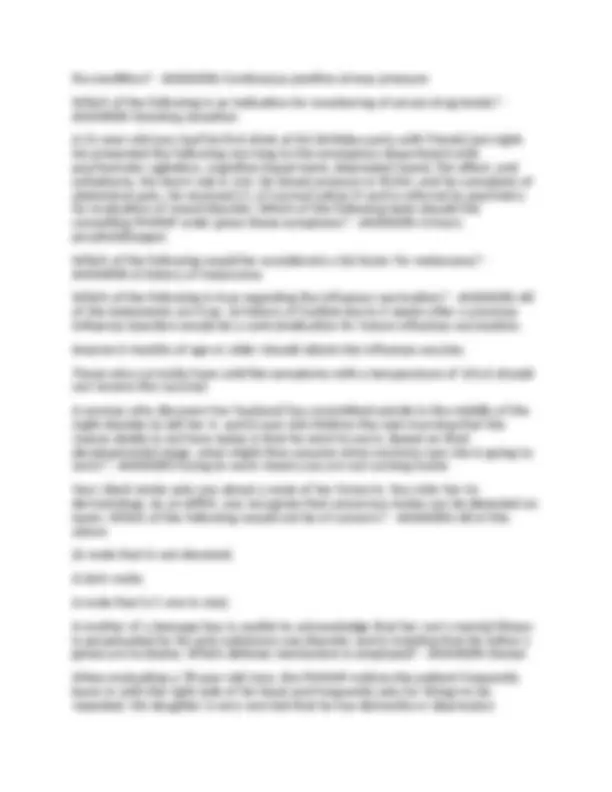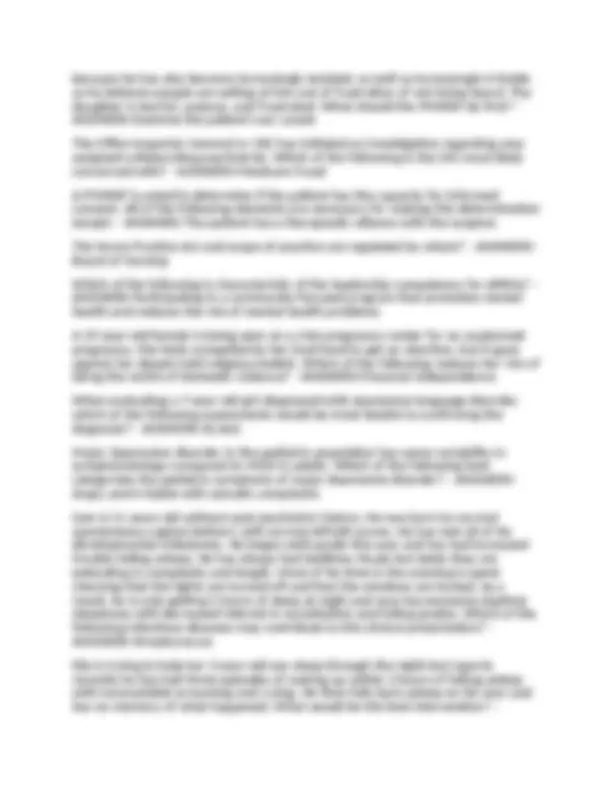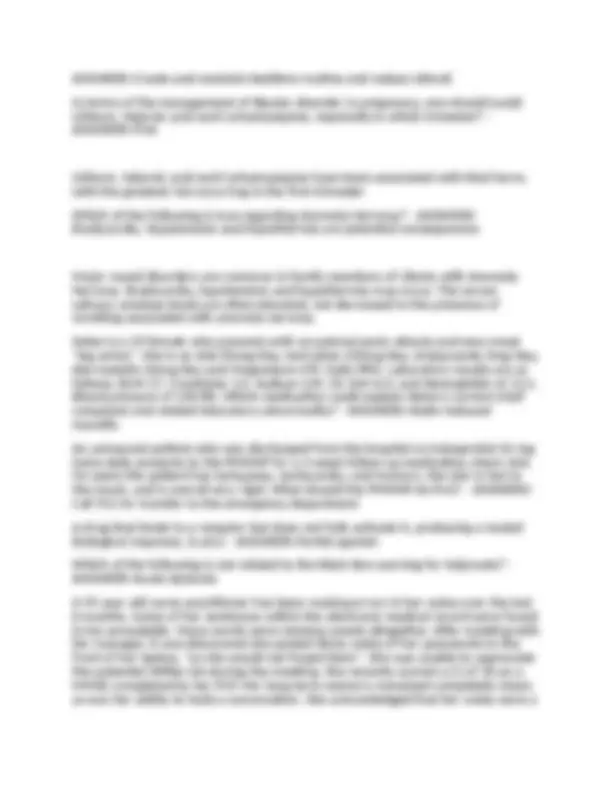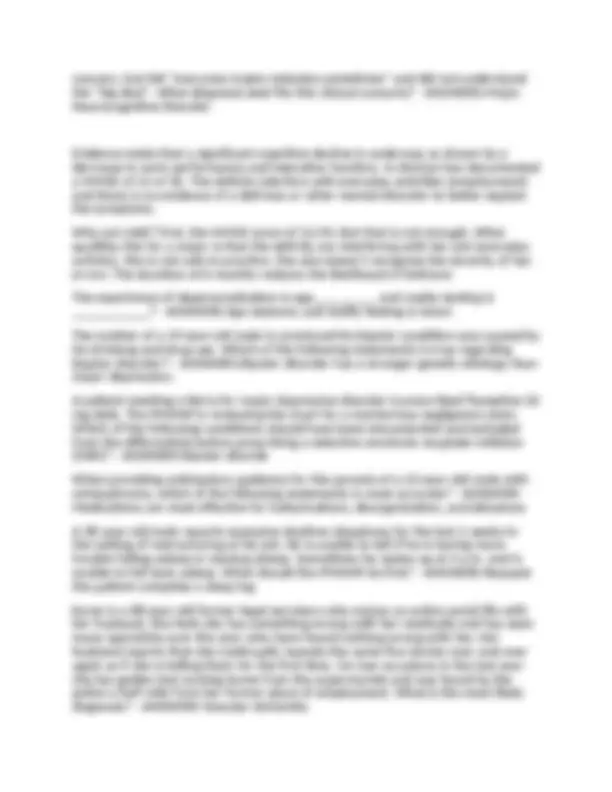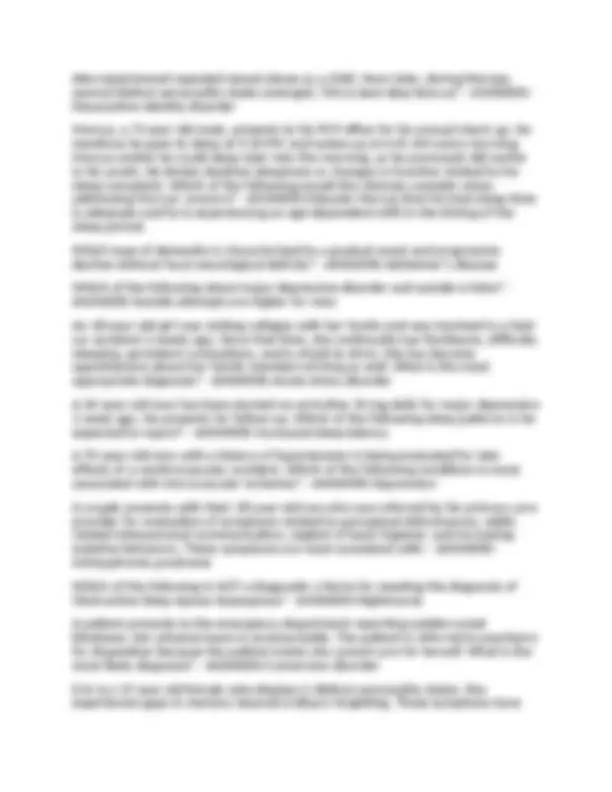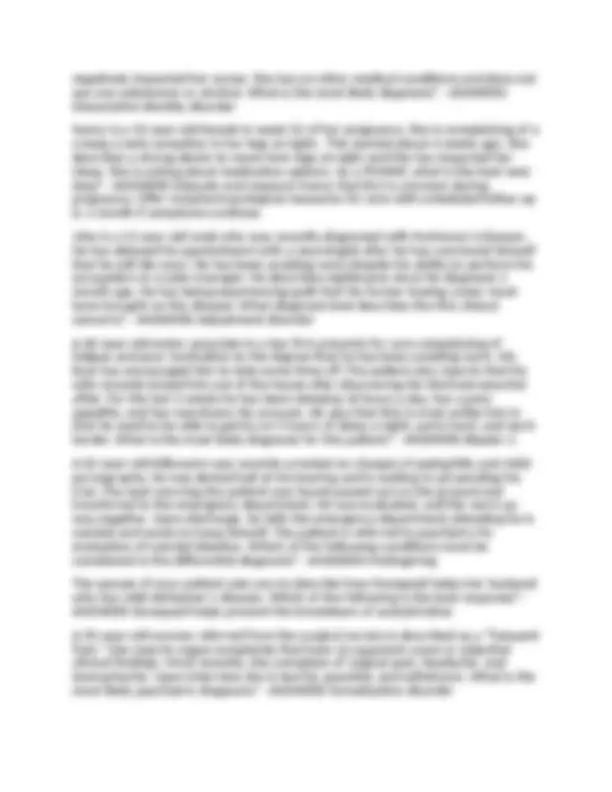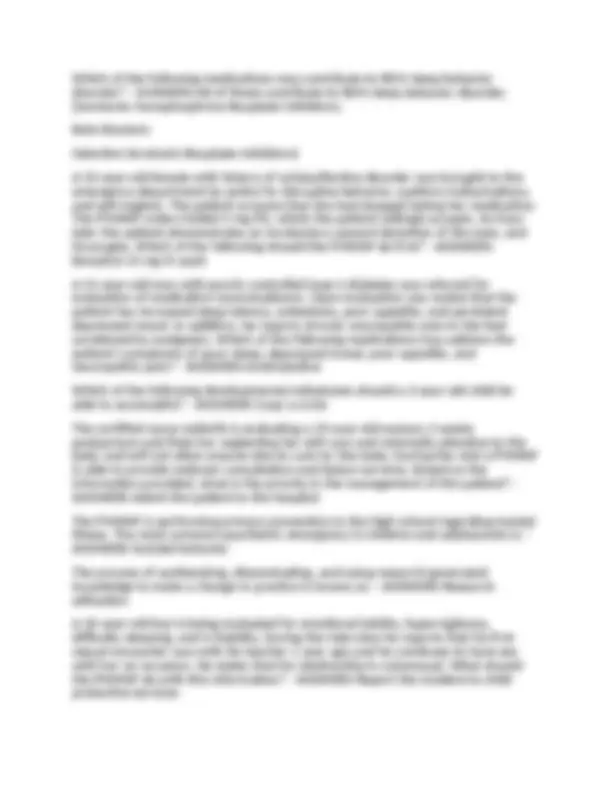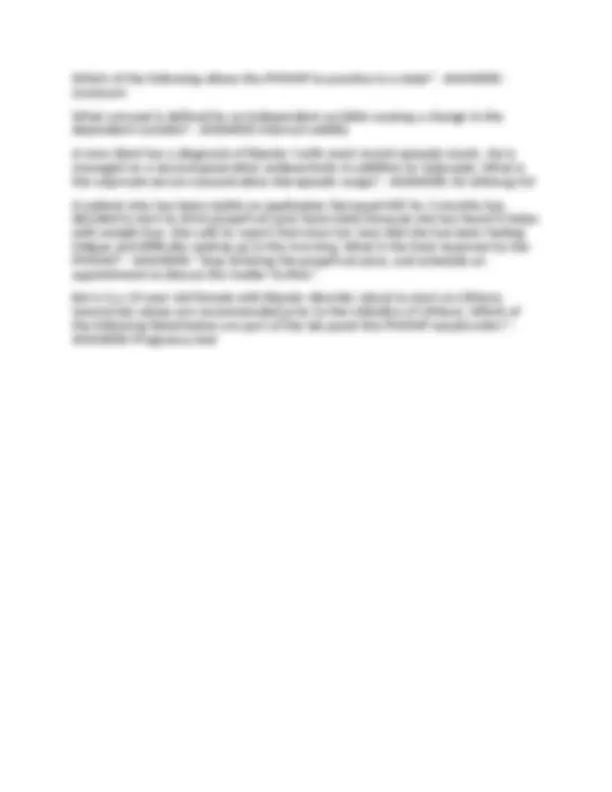Download Clinical Education Associates (CEA) PMHNP Certification Review (2025), Graded A+ Pass. and more Exams Nursing in PDF only on Docsity!
Clinical Education Associates (CEA) PMHNP Certification Review
(2025), Graded A+ Pass.
Conduct d/o - ANSWERS-violates others, destruction, robbery, bullying, truant before age 13 Tx: early intervention, screening, school-based programs, CBT, SSRIs, Risperdal and other antipsychotics Oppositional Defiant d/o - ANSWERS-upsets those around child, vindictive, angry, hostile, argues w/ authority/rules/adults, blames others Tx: family interventions, eliminate punitive parenting, use praise, ignore bad behavior, role play Disorder Hereditibility - ANSWERS-High: Autism, Tourette's s/o, Bipolar d/o, Schizophrenia Medium-High: ADHD Medium: ODD, Alzheimer's, OCD, Conduct d/o, Borderline PD, NPD, Antisocial PD, Histrionic PD Low-Medium: MDD Low - AUD, GAD, Panic d/o, Cluster A (paranoid, schizoid, schizotypal) Insecure/Ambivalent (Attachment Theory) - ANSWERS-uncertain, suspicious, target of bullying, caregiver threatens abandonment as punishment Insecure/Avoidant (Attachment Theory) - ANSWERS-expects caregiver rejection, shows no preference between parent & stranger, caregiver is hostile/angry/sarcastic Insecure Disorganized (Attachment Theory) - ANSWERS-frightened of caregiver, abuse, more likely to develop conduct d/o Reactive Attachment D/O (Attachment Theory) - ANSWERS-- a DSM-5 Trauma and Stress related d/o
- child rarely seeks comfort when distressed
- child rarely responds to comfort when distressed
- conditions of social neglect in first months of life
- features manifest between 9 months-5 years of age
- prognosis follows caregiving quality following neglect Jean Piaget Stages of Development - ANSWERS-Sensorimotor: birth-2y/o; understand world vs senses; object permanence Preoperational: 2-7 y/o; understand world though language and mental images; egocentric; imagination Concrete Operational: 7-12 y/o; understand world through logical thinking and other point of view; conservation Formal Operational: 12+; understand world through hypothetical thinking, abstract and scientific; ethics and moral issues explored Abraham Maslow - Self Actualization Theory - ANSWERS-Physiological ("deficiency needs"): food, water, shelter, clothing, etc Safety: protection from violence, health, emotional/financial security Love & Belonging: human interaction Esteem: ego-driven, respect from others and self Self-Actualization ("growth need"): realization of one's full potential Erik Erikson's 8 Stages of Development - ANSWERS-Infancy: basic trust vs mistrust Toddler: autonomy vs shame/doubt
ADHD - ANSWERS-- symptoms start prior to 12 y/o, last >6months, in more than 1 setting
- 5% of children, 2.5% of adults
- 2:1 male/female
- risk for conduct d/o and antisocial d/o
- Vanderbilt Scale (parents 55 questions, teachers 43 questions) validated for 6- year olds incidence vs prevalence - ANSWERS-incidence: # of newly dx'd cases of dz w/in a time period prevalence: total # of all cases existing in a population during a time period CN XII (Hypoglossal) - ANSWERS-tongue deviation to right or left CNVIII (Vestibulocochlear) - ANSWERS-whisper test Cranial Nerves (CN) - ANSWERS-I: Olfactory ("sniff test") II: Optic (visual acuity, # of fingers in central field, Snellen eye chart, visual field) III: Oculomotor (PERRLA, eyelid raises) IV: Trochlear (eye movement down/lateral) V: Trigeminal (chewing, facial sensation, corneal reflex) VI: Abducens (eye movement laterally, outward gaze) VII: Facial (facial expression, symmetry, sour/sweet taste) VIII: Vestibulocochlear (Acoustic) (hearing, balance) IX: Glossopharyngeal (gag reflex, swallow) X: Vagus (vocal qualty, gag reflex, gutteral sound at back of throat) XI: Accessory (Spinal) (shrug shoulders, head side to side) XII: Hypoglossal (tongue position midline w/o tremor, tongue movements side to side w/o tremor) Left Cerebral Hemisphere - ANSWERS-Broca's area Numeric/math skills Reasoning
Logic Reality based Thinking in words Positive emotions Right Cerebral Hemisphere - ANSWERS-Expression Imagination Daydreaming REM sleep Intuition Musical awareness Negative emotions Grey Matter - ANSWERS-Neural cell bodies Axon terminals Dendrites Nerve synapses diseases: neurodegenerative White Matter - ANSWERS-Bundles of myelinated axons Oligodendrocytes produce myelin Send nerve signals up and down spinal cord diseases: MS, strokes, spinal cord injury Nervous System - ANSWERS-CNS: brain, spinal cord PNS: Autonomic (sympathetic, parasympathetic); Enteric (GI); Somatic (Afferent, Efferent) Nerve Impulse Direction - ANSWERS-Afferent (arrives at) Efferent (exits from) Autonomic Nervous System - ANSWERS-Sympathetic:
Dopamine (DA) - ANSWERS-- movements
- pleasure
- reward
- motivation
- psychosis
- attention
- nausea
- prolactin secretion Acetylcholine (Ach) - ANSWERS-- alertness
- learning
- memory Glutamate - ANSWERS-- excitatory
- learning
- memory
- thought processing GABA - ANSWERS-- inhibitory
- relaxation
- sedation Frontal Lobe - ANSWERS-- personality
- modify emotions to what is "acceptable"
- prefrontal cortex weighs consequences
- executive function
- maintaining focus
- motor cortex (walking)
- damage to left frontal lobe is associated with depression
- damage to Broca's area may result in expressive aphasia
- contains the most dopamine sensitive neurons in the cortex
Temporal Lobe - ANSWERS-- Hippocampus: explicit memory (LTM of facts and events), reality testing, inhibits amygdala, PTSD may shrink hippocampus
- Sexual identity
- Language comprehension
- Processing
- Learning
- Frontotemporal dementia Basal Ganglia & "neighbors" - ANSWERS-- Voluntary movement
- Motor control
- Caudate nucleus + Putamen = Corpus striatum
- Corpus striatum is the gate keeper for movements
- Nucleus accumbens: pleasure, reward, abuse, positive reinforcement, addiction
- Thalamus: relay station of all motor movements and sensory info such as hearing, taste, sight and touch. Routes info to cerebral cortex (outer layer of brain) for interpretation
- Hypothalamus: neuroendocrine role over anterior pituitary, hormones (body temp, hunger, thirst, fatigue, sleep, circadian rhythm, BP, HR, sexual behavior)
- Pineal gland: melatonin
- Amygdala: fear, rage, stress response
- Limbic system: basic instincts, processing information (sexual arousal, anger, pleasure, reward, memory, motivation)
- Cingulate gyrus: a part of the limbic system that assigns emotional value, directs attentions towards emotional significant events. Smaller size in schizophrenia NOTE: Consciousness results from cerebral cortex & thalamus constant interaction
24 months: runs, kicks large ball 24 months: build a tower of 6 cubs 36 months: rides tricycle 48 months: stand on 1 foot for 5+ seconds 48 months: brushes teeth 5 years: plays competitive exercise games 6 years: rides 2-wheel bicycles 6 years: ties shoelaces Language Developmental Milestones - ANSWERS-- 6 months: responds to hearing own name
- 12 months: recognizes "no", own name
- 18 months: understands up to 150 words
- 24 months: responds simple commands
- 36 months: understands size, body parts, uses sentences
- 4 years: able to define words Fetal Alcohol Syndrome (FAS) - ANSWERS-- leading cause of preventative congenital anomalies
- leading cause of developmental disabilities Clinical features:
- flat nasal bridge smooth philtrum (ridge under nose between lips)
- thin upper lip
- epicanthal folds
- anteverted nares
- growth retardation
- possible CNS abnormalities: abnormal reflexes, abnormal tone, seizures Binge Eating D/o - ANSWERS-- most common eating d/o
- common in normal weight, overweight and obese
- occurs w/ stress, perceived lack of control
- remission rates higher compared to anorexia, bulimia
- Treatment: psychotherapy, CBT (1st line), elf help groups, SSRI, other medications Anorexia Nervosa vs Bulimia Nervosa - ANSWERS-AN:
- ego syntonic
- BMI < 18
- less likely to seek help
- refuses to eat with family
- dental enamel erosion
- amenorrhea
- hypotension, bradycardia
- hypothermia
- anemia, leukopenia, thrombocytopenia BN:
- ego dystonic
- BMI > 18.
- more likely to seek help
- describes family as neglectful, conflict
- dental enamel erosion
- hypokalemia, hypochloremia, elevated serum amylase, hyperphosphatemia, metabolic alkalosis (vomiting0 or metabolic acidosis (laxatives) Key Lab Values Accross the Lifespan - ANSWERS-TSH 0.5-5.0 mlU/L AST 1-40 U/L ALT 7-56 U/L Na 135-145 mEQ/L K 3.5-5.0 mEQ/L
- Gonorrhea
- Chlamida HIV Screening - ANSWERS-All pregnant women during 1st trimester Key Lab Values Accross the Lifespan - ANSWERS-HDL <40mg/dl; >60mg/dl LDL 130-159 (borderline high), 160-189 (high), >189 (very high) Trigs >199mg/dl (high) A1c >5.6% Fasting glucose <100 (normal), >125 x2 (DM) T2DM Risk: prediabetes, overweight, >44y/o, 1st FHx, sedentary, hx of Gestational DM, black, hispanic, native american, alaskan BMI - ANSWERS-<18.5 (underweight) 18.5-24.9 (wnl) 25.0-29.9 (overweight) 30.0-34.9 (obese)
34.9 (morbid obesity) Birth Weight (Am Academy of Pediatrics) - ANSWERS-- Newborn wt decreases 7- 10%
- Wt doubles at 5 months
- Wt triles at 12 months
- breast feeding recommended for 1st 6 months Blood Pressure (2017 ACC/AHA; JNC) - ANSWERS-120/79 (normal) 121-129/79 (elevated) 130-139/80-89 (Stage I HTN) 140/90 (Stage II HTN) Goal >60 y/o w/o DM/CKD: 150/ Goal for any age w/ DM/CKD: 140/
Tx:
- Black w/o CKD: CCB or Thiazide
- Nonblack: Thiazide, ACEI, ARB, CCB
- All races w/ CKD: ACEI, ARB BB are never 1st line Hypoglycemia s/s - ANSWERS-tremor, palpitations, anxiety, sweating, hunger, parasthesia, delierium, stupor, seizure, confusion, weakness, drowsiness occur if glucose <70 mg/dl Miosis - ANSWERS-pupil constriction causes: antipsychotics, acetylcholine, opiods, clonidine, trauma mydriasis - ANSWERS-pupil dilation causes: anticholinergics, cocaine, disease, trauma Neuroleptic malignant syndrome - ANSWERS-a life-threatening, neurological disorder most often caused by an adverse reaction to neuroleptic or antipsychotic drugs Symptoms include: -High fever -Sweating -Unstable blood pressure -Stupor -Muscular rigidity -Autonomic dysfunction Extrapyramidal symptoms (EPS) - ANSWERS-Caused by: antipsychotics, dopamine blockade
Adventitious: diseaster scenario that impacts one's well being w/o warning (eg. war, earthquake) Situational: unexpected events that disturb one's psychological well being (eg. death, job loss) Psychotherapy Terms - ANSWERS-Transference: client's feelings, behaivors, or thoughts, from a previous rleationship are felt towards the therapist Positive Transference Example: regular, consistent attendance, showing up on time Negative Transference Example: showing up late, unwilling to share Countertransference: feelings of the therapist towards the client Autognosis: using one's own's feelings to better understand what is occuring with the pt Resistance: pt's unwilliness to change w/ therapy. Examples: asking therapist personal questions, silence, seductiveness, skipping appts Contagion: behavior is copied, mimicked, or triggered by others in the vicinity Primative Defense Mechanisms - ANSWERS-Denial: refusing to acccept reality Projection: deny attribute in themselves and instead attribute the attribute onto others Immature Defense Mechanisms - ANSWERS-Acting out: replace a conscious thought or experience w/ an impulsive action Regression: go back to previous level of development to aoid emotional pain
Hypochondria: unacceptable feelings cause one to amplify an illness Introjection: take on, internalize or replicate another's attributes Somatization: an emotion manifests or is changed into a body system Splitting: all or nothing thinking instead of viewing self or others as a whole Neurotic Defense Mechanisms - ANSWERS-Displacement: move the emotion to a different recipient Dissociation: avoid emotional stress via altered state of consciousness Intellectualization: using thinking and intelligence to avoid feeling emotion Rationalization: offer excuse to explain unacceptable feelings or behavior Reaction Formation: deal w/ unacceptable impulse by exaggerating the opposite feeling Repression: prevent an unacceptable thought or idea from consciousness Mature Defense Mechanisms - ANSWERS-Sublimation: transform socially unacceptable impulse into a socially acceptable one Suppression: consciously forgetting or ignoring an unpleasant feeling Altruism: aoviding one's own pain by doing good for others Humor: when humor or comedy is used to express thoughts without pain
tx for: OCD, ADHD, SUD Conditioning:
- classic: association, Pavlov
- operant: reinforcement, Skiner Cognitive Therapy - ANSWERS-"negative thinking leads to problematic behavior" identify and replace negative thoughts w/ postive and flexible ways of thinking uses: homework, journaling tx for: depression, anxiety d/o Cognitive Behavior Therapy (CBT) - ANSWERS-collaborative problem solving w/ reality testing between therapist and pt uses: education, exposure, homework, Socratic dialogue, questioning, mutual discovery, downwared arrow technique gets to the core assumptions, revealing/labeling/restructuring cognitive distortions Goal: self-reliance Emotion Focused Therapy (EFT) - ANSWERS-Memory consolidation: the more intense an emtion, the more it will form a lasting memory Memory reconsolidation: memory can be changed/altered w/ psychotherapy, including EFT Gestalt style experiments: evokes problematic feelings then allocates them into common buckets/markers, which have specific solutions/interventions (eg. breathing techniques, imagery/visualization/positive phrase repetition)
Goal: change emotional state used to: reduce guilt, anger, secondary emotions by reprocessing emotions to access the information emotions provide, then moving forward Existential Psychotherapy - ANSWERS-Making peace w/ the inevitability of death allows one to live a more meaningful life. Embrace angst and anxiety. Take responsibility to create your purpose. "4 Worlds":
- physical dimension
- social dimension
- psychological dimension
- spiritual dimension Therapy Goals:
- increase self awareness
- decrease dependence on others for validation
- "be here & now" principle of presence
- explore meaning, purpose, and valuate
- happiness is based on having the freedom to choose one's path and make changes Gestalt Psychotherapy - ANSWERS-Enactment leads to self awareness. Integrated "whole" person or the whole is greater than the sum of its parts. The pt must bring on or evoke the negative feeligns in the present, during the session ot resolve issues. Methods:
- I-Thou Relationship: creat a self environmetn which helps focus on the immediate expereince and thus feeling understood. Using creative experiments, ask the pt "what are you experiencing right now" as the pt moves through

